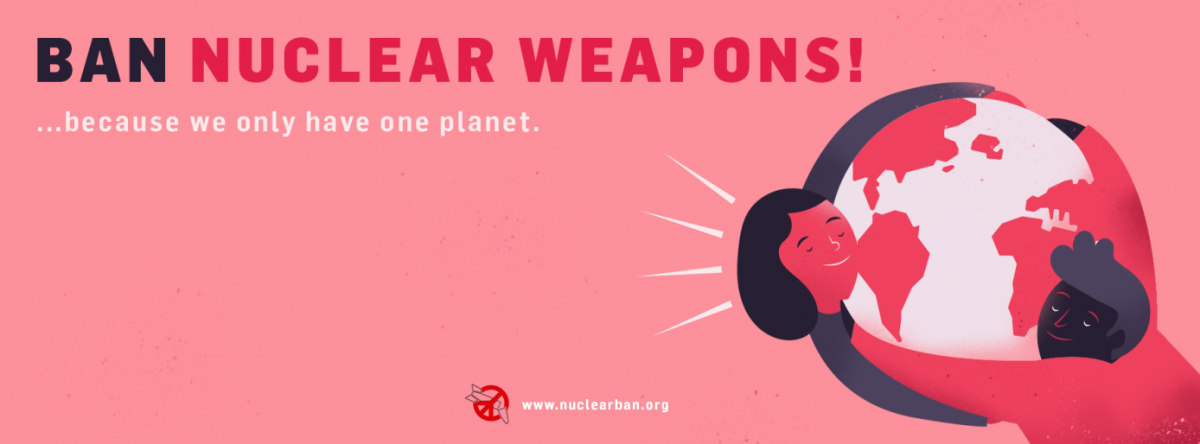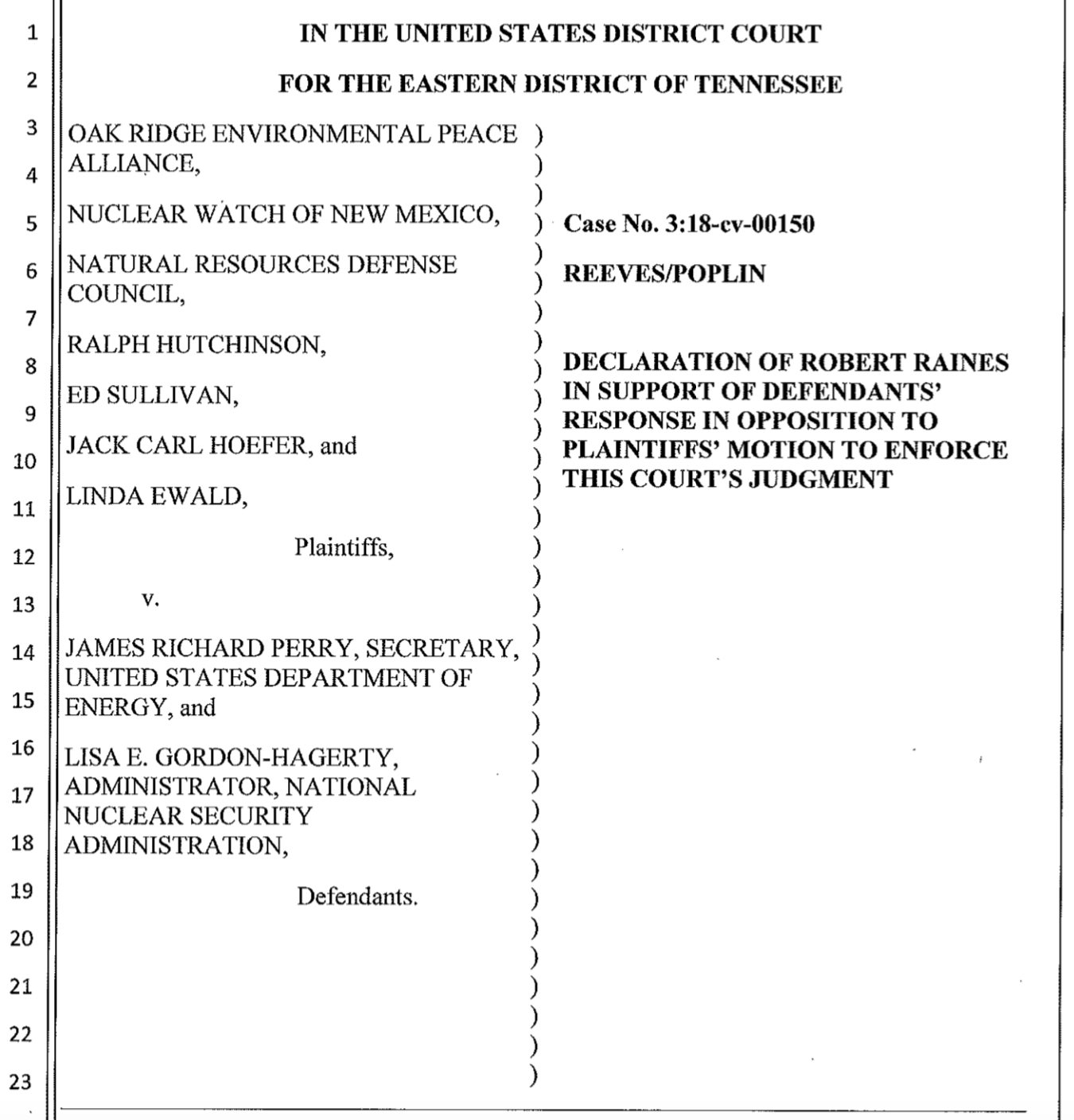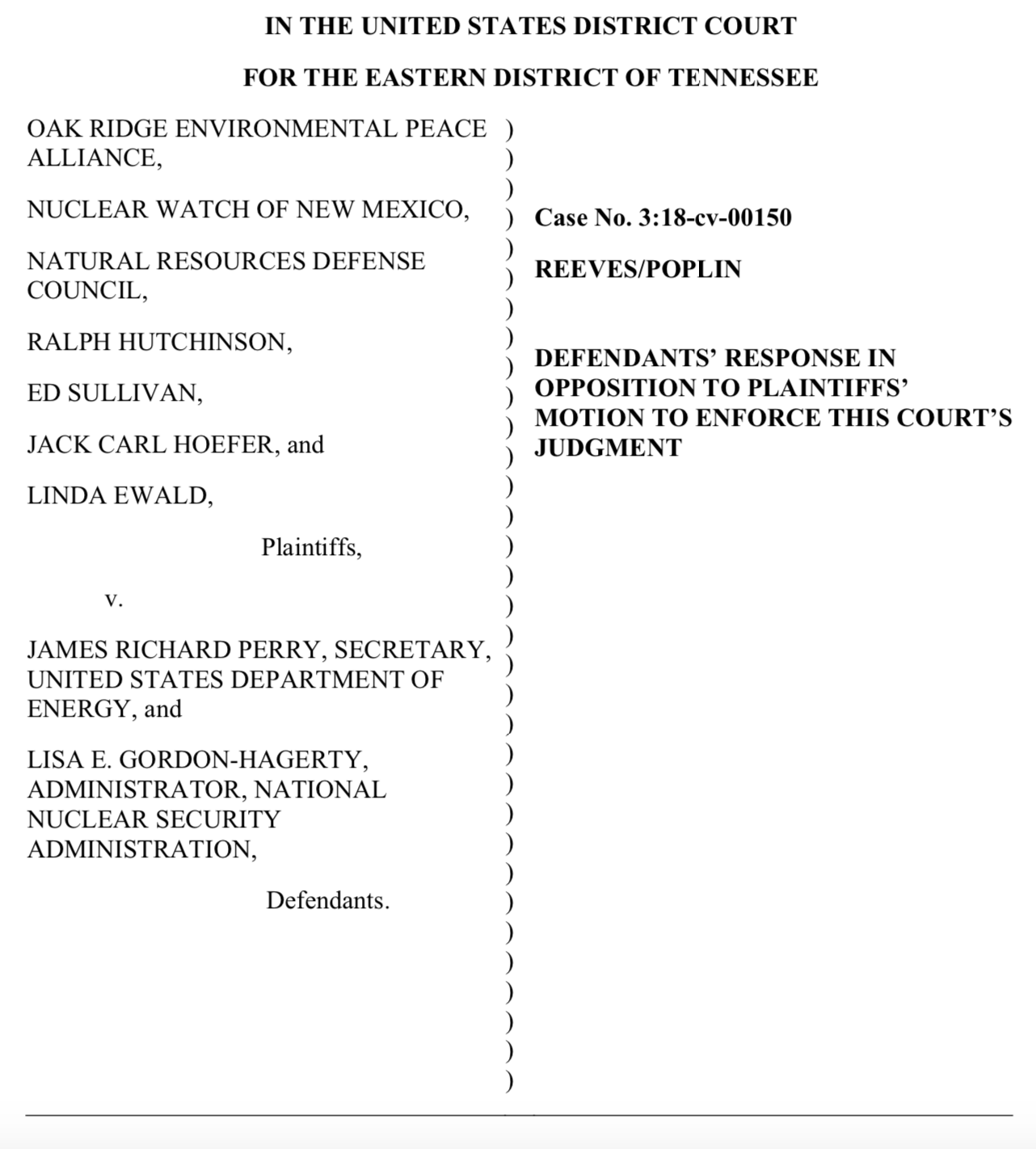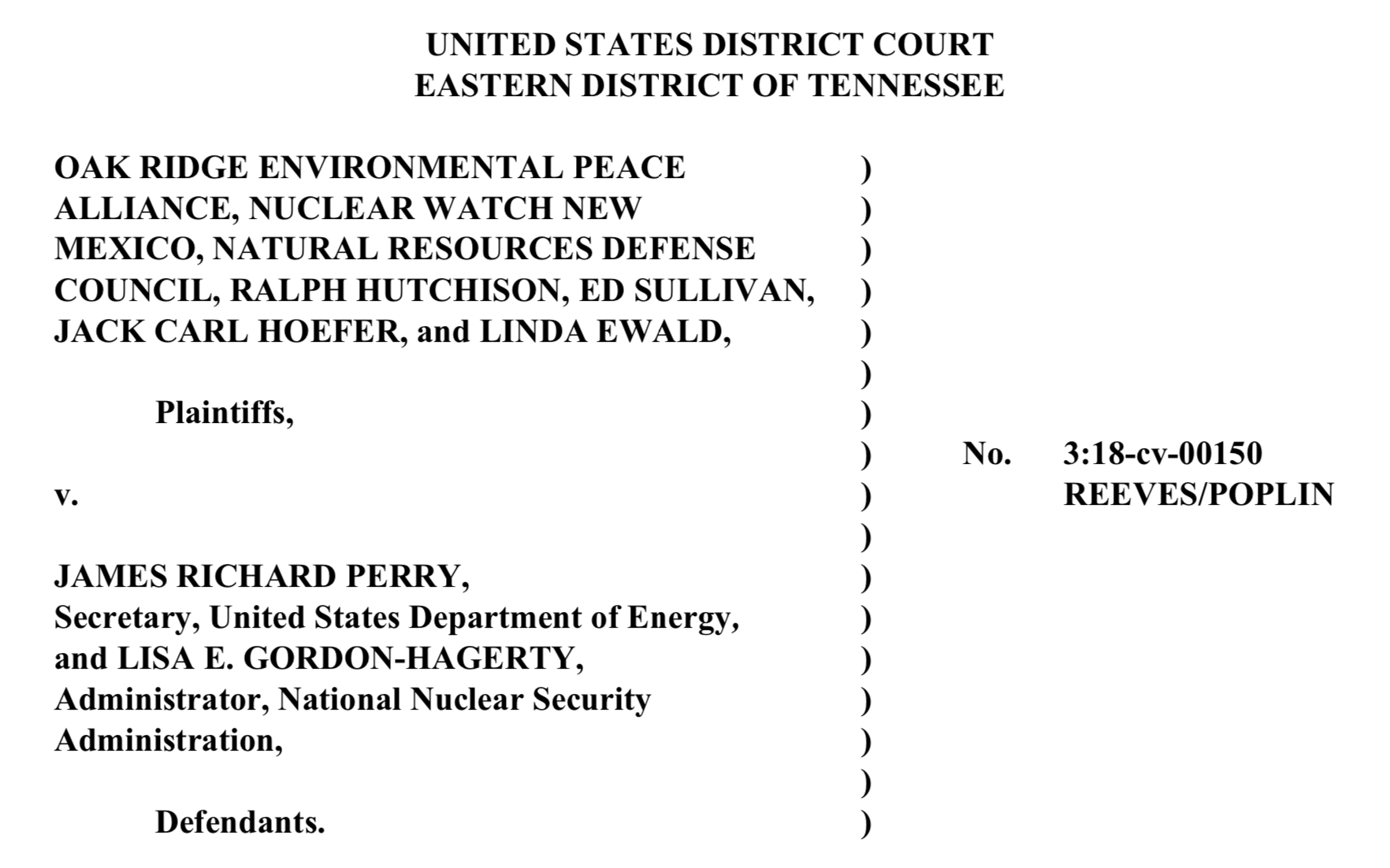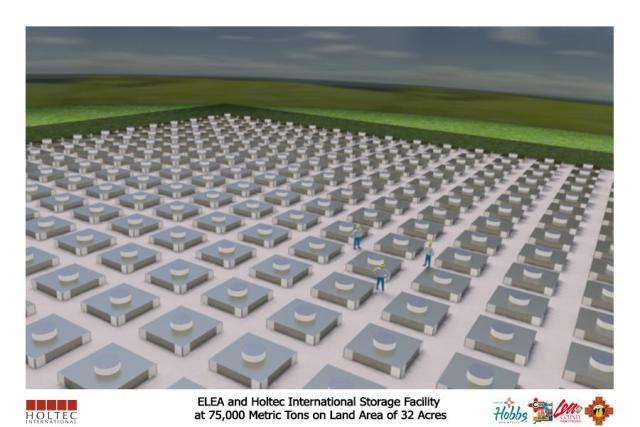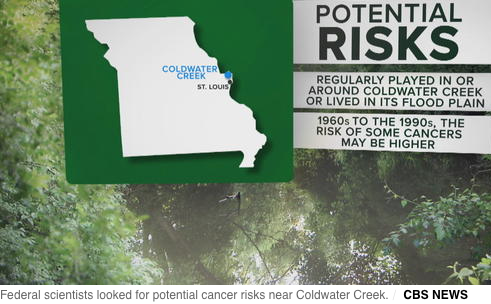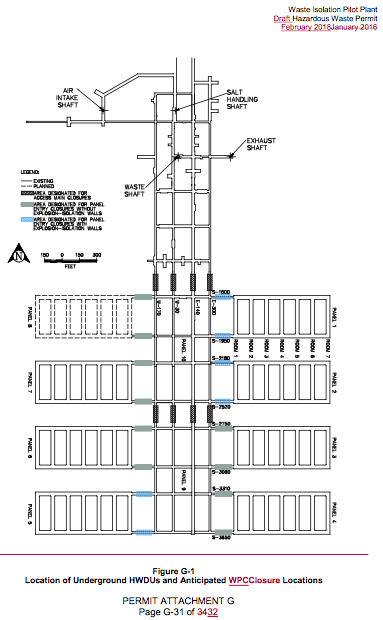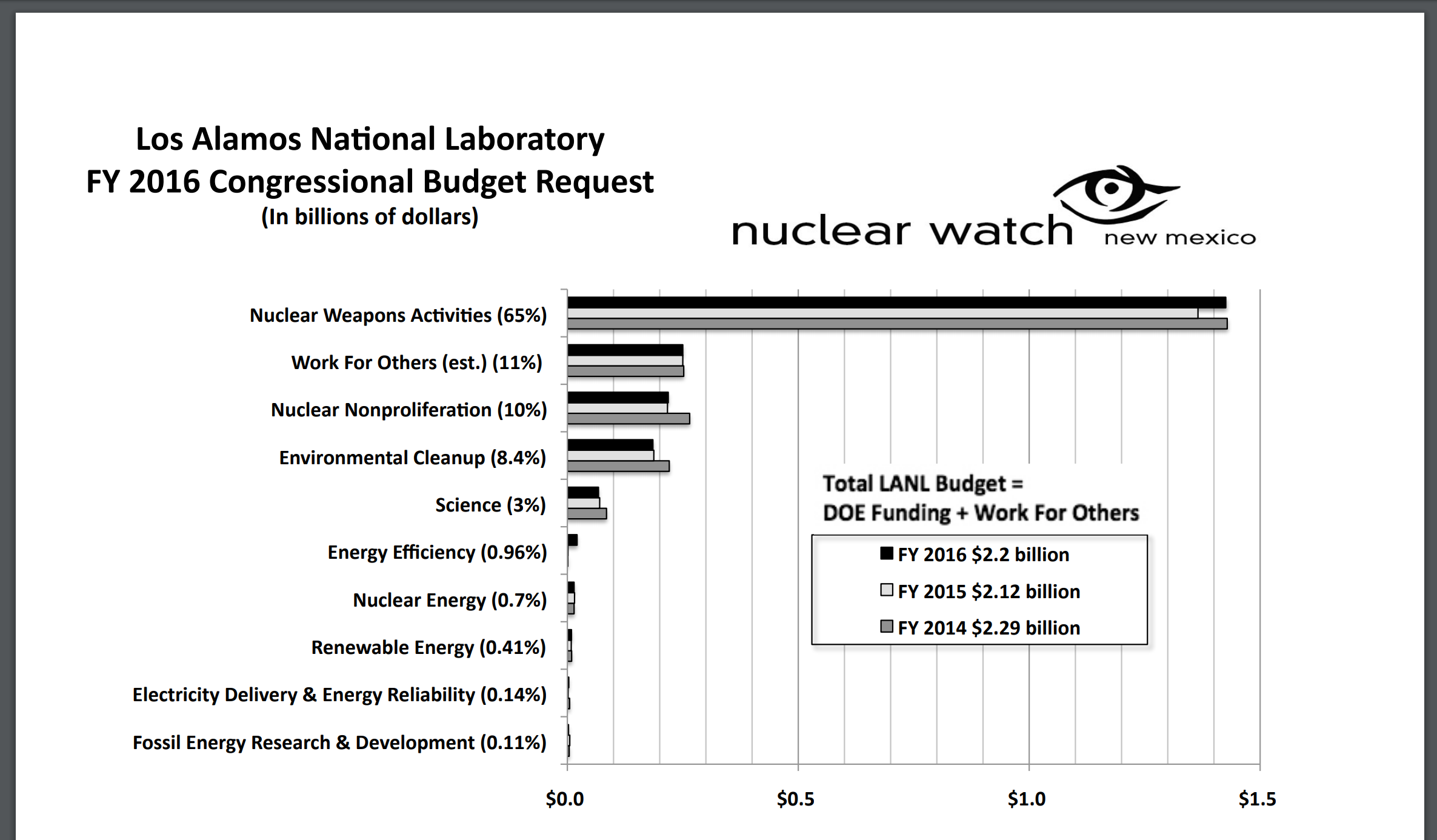2020
America’s Ageing Nuclear Fleet Underprepared For Climate Change
Last year, Bloomberg conducted a review of “correspondence between the commission and owners of 60 plants” and made some terrifying discoveries. According to their own risk assessments, “54 of their [60] facilities weren’t designed to handle the flood risk they now face.”
By: Haley Zaremba / oilprice.com
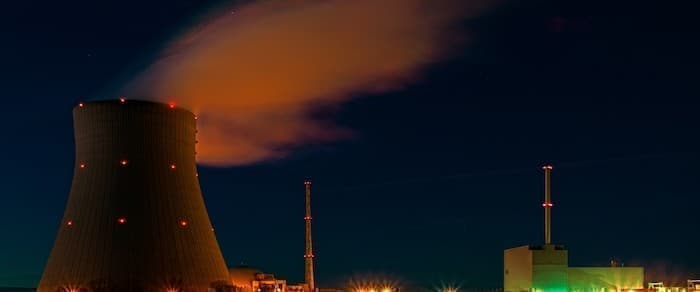
The United States is not only one of the first and foremost nuclear powers of the world, it has also long been the nuclear powerhouse of the planet, being responsible for a whopping two thirds of global nuclear energy production. Domestically, the United States’ nuclear power plants account for approximately 20 percent of the nation’s total electricity and produce over 50 percent of the entire country’s carbon-free energy generation. But these superlatives, both global and domestic, won’t last. As nuclear energy grows around the world, the industry is in deep trouble in the U.S., where the aging nuclear fleet has been battered by a flood of cheap shale oil and natural gas, and is now barely clinging to life thanks to hefty government subsidies and leaving the shockingly high cost of radioactive waste maintenance to the taxpayers.
“The riskiest period of the Cold War was its earliest stages, when military and political leaders didn’t yet fully understand the nature of what Hiroshima had demonstrated. Emerging technologies like AI [artificial intelligence] threaten to plunge us back into that uncertainty.”

How new tech raises the risk of nuclear war
75 years after Hiroshima and Nagasaki, some experts believe the risk of the use of a nuclear weapon is as high now as it has been since the Cuban missile crisis. | axios.com
New Video Shows Largest Hydrogen Bomb Ever Exploded
A Russian nuclear energy agency released formerly classified footage of the Soviet Union’s 1961 Tsar Bomba test.
BY: William J. Broad | nytimes.com
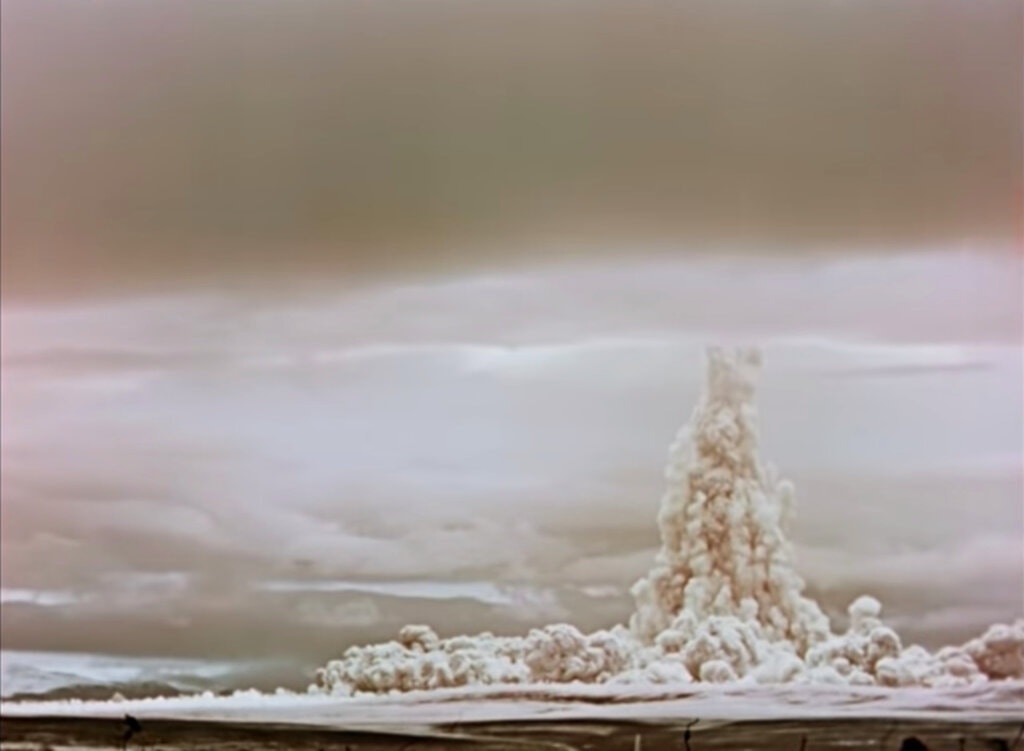
Hydrogen bombs — the world’s deadliest weapons — have no theoretical size limit. The more fuel, the bigger the explosion. When the United States in 1952 detonated the world’s first, its destructive force was 700 times as great as that of the atomic bomb that destroyed Hiroshima.
And in the darkest days of the Cold War, the Soviets and the Americans didn’t only compete to build the most weapons. They each sought at times to build the biggest bomb of all.
Russia Releases “Tsar Bomba” Test Footage Of The Most Powerful Nuclear Bomb Blast Ever
This previously classified film provides a new and fascinating glimpse into the 50-megaton Cold War nuclear test that occurred nearly six decades ago.
Don’t Preach Nuclear Arms to Archbishop
“That $2 trillion nuclear weapons modernization will do nothing to protect us against the global pandemic impacting Americans now. Further, the Sandia and Los Alamos labs may actually degrade national security with planned new nuclear weapons designs that can’t be tested because of the global testing moratorium. Or worse yet, this may prompt the U.S. back into testing, throwing more gas on the fire of the new nuclear arms race.”
BY: JAY COGHLAN / NUCLEAR WATCH NEW MEXICO, SANTA FE
Monday, August 24th, 2020 at 12:02am
 In response to (the Aug. 13) editorial “Archbishop’s nuclear weapons view needs a homily on reality,” I was one of the speakers at the 75th anniversary commemoration of the Hiroshima atomic bombing, organized by Fr. John Dear, at which Santa Fe Archbishop John Wester eloquently spoke. The editorial declared “neither Wester nor Dear appear to accept the premise there is any deterrent benefit to the nuclear arsenal.”
In response to (the Aug. 13) editorial “Archbishop’s nuclear weapons view needs a homily on reality,” I was one of the speakers at the 75th anniversary commemoration of the Hiroshima atomic bombing, organized by Fr. John Dear, at which Santa Fe Archbishop John Wester eloquently spoke. The editorial declared “neither Wester nor Dear appear to accept the premise there is any deterrent benefit to the nuclear arsenal.”
To the contrary, the Journal perpetuates the delusion that the U.S. nuclear arsenal is just for deterrence, a premise fed to American taxpayers since the beginning of the Cold War. Instead, the U.S. arsenal has always been about nuclear warfighting, starting with the simple fact that we were the first to use it. This continues to this day, as the Pentagon made clear in a 2013 nuclear policy declaration: “The new guidance requires the United States to maintain significant counterforce capabilities against potential adversaries. The new guidance does not rely on a ‘counter-value’ or ‘minimum deterrence’ strategy.”
NOTE: This study has notable implications since the New Mexico congressional delegation touts expanded nuclear weapons programs as an economic engine for northern New Mexico.
Study: Neighboring counties lose money due to LANL
BY: KYLE LAND Copyright © 2020 Albuquerque Journal
SANTA FE — A study conducted by University of New Mexico researchers found that Los Alamos National Laboratory has a negative economic impact on nearby communities, despite employing many people in the area.
Of the seven counties included in the study, governments in six of them were found to be losing money due to LANL’s impact, with the exception of Los Alamos. Those counties include Santa Fe, Rio Arriba, Sandoval, San Miguel, Taos and Mora.
The study, conducted by UNM’s Bureau of Business and Economic Research, found Los Alamos County gained $13 million from economic activity created by the lab, while all other counties lost an average of $1.25 million.
Santa Fe and Rio Arriba counties, home to 40% of the Lab’s employees, had the largest losses, at more than $2 million.
In a Friday presentation of the findings to the Regional Coalition of LANL Communities, Bureau Director Jeff Mitchell said his team calculated how much revenue LANL employees produce for an area versus what it costs a local government to provide services for them.
The study, Mitchell said, found that LANL and its employees tend to spend their money in only a few places.
Thirty-eight percent of the Lab’s spending actually goes to Bernalillo County, with another 42% staying within Los Alamos County, according to the study.
“Trump is dedicated to destroying the arms control regime. It may already be too late to renegotiate [the new START treaty], the last of the arms control treaties. He is now threatening to carry out nuclear weapons tests, tests that would undermine the Comprehensive Test Ban Treaty, almost 30 years. The United States never ratified it, but it has lived up to it. All of this opens the door wider for other countries to react the same way. The arms industry is of course euphoric. They’re getting huge new contracts to develop major weapons to destroy all of us. This encourages others to do the same. So there are new contracts down the road for hopeless means to try to defend ourselves against the monstrosities that we’re helping to construct. This is Trump, racing toward this, apparently enjoying it…Whether this can be contained within the constitutional structures of the United States, we don’t know.”
Noam Chomsky on Trump’s Troop Surge to Democratic Cities & Whether He’ll Leave Office if He Loses
Trump Administration Sends Mixed Signals on Nuclear Weapons Budgeting
“A Senate-passed proposal would grant the Nuclear Weapons Council new authority to edit NNSA’s budget request after the Energy Department crafts it and before the request is submitted to the White House budget office.”
BY:Joe Gould & Aaron Mehta
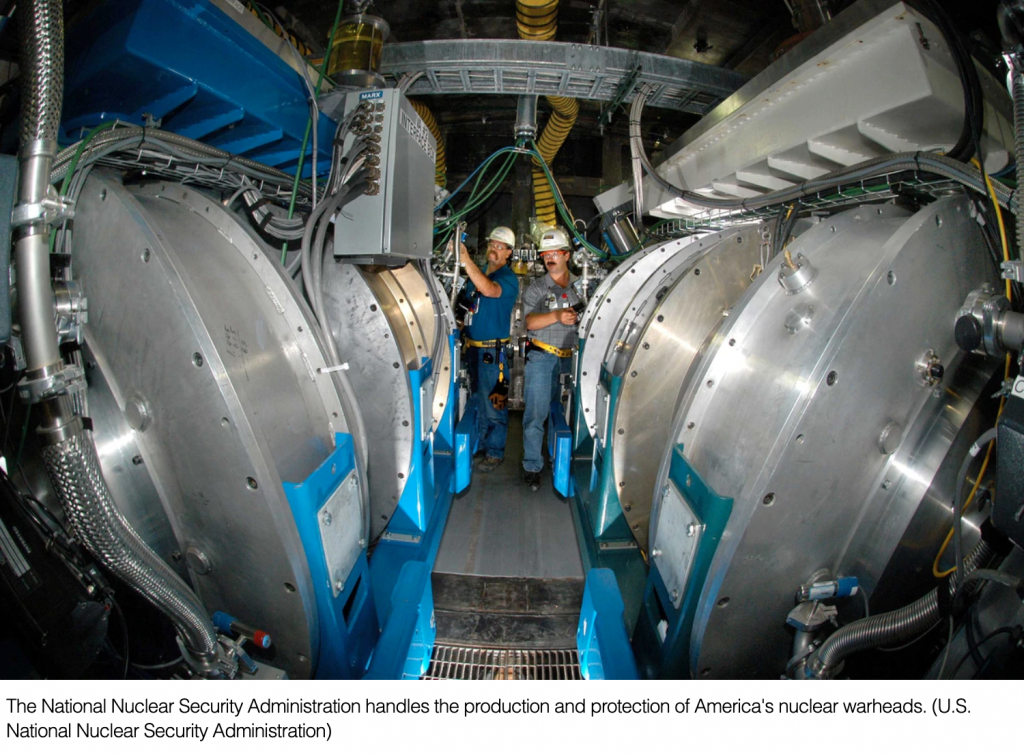
WASHINGTON ― Defense hawks in Congress are pushing a contentious plan to give the Pentagon a stronger hand in crafting nuclear weapons budgets, but the Trump administration has been sending mixed messaging over recent weeks about whether the change is needed.
The Senate-passed version of the annual defense policy bill would give the Pentagon-led Nuclear Weapons Council a say in the budget development of the National Nuclear Security Administration, a semi-autonomous agency within the Department of Energy that’s responsible for the stockpile’s safety, security, and effectiveness.
NOTE: This article is illustrative of the absolutely key role New Mexico plays in the new nuclear arms race, far beyond just the Los Alamos and Sandia Labs. The Air Force Nuclear Weapons Center is on Kirtland Air Force Base which shares runways with the Albuquerque, NM airport. The new nuclear arms race will be increasingly dangerous with likely hypersonic and cyber weapons.
US Air Force May Have Accidentally Revealed Interest in Hypersonic Nuke
BY: Valerie Insinna
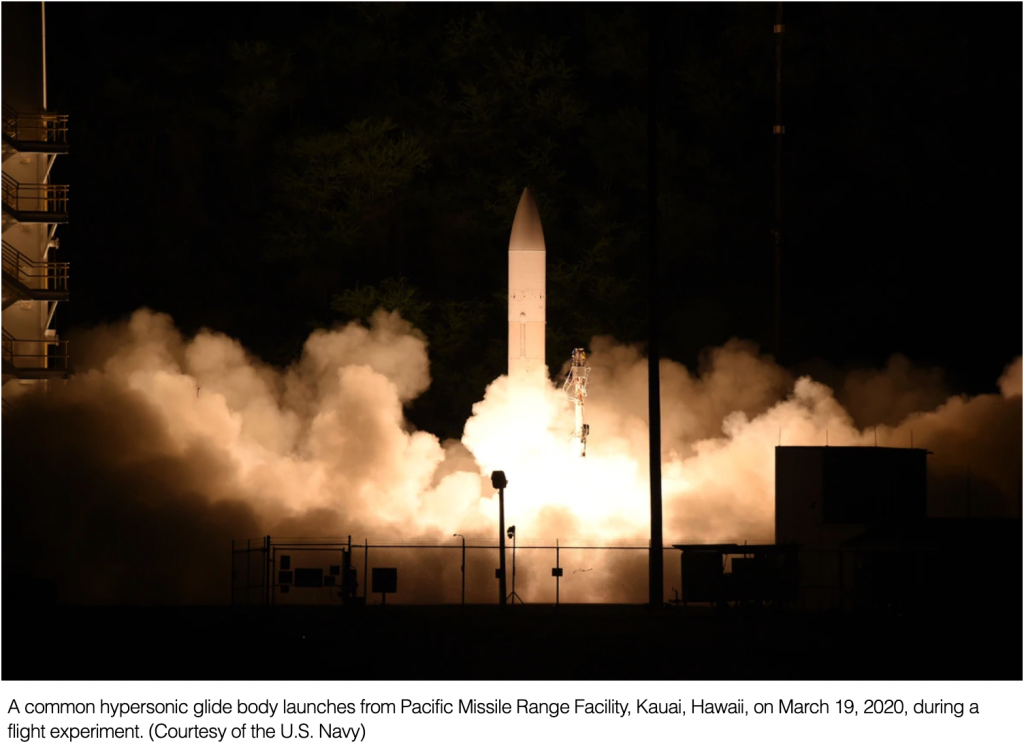
WASHINGTON — The U.S. Air Force has issued, and quietly revoked, a solicitation to industry seeking technologies that would support a hypersonic glide vehicle capable of traversing intercontinental ranges, potentially signaling the military’s interest in a hypersonic nuclear weapon.
According to an Aug. 12 request for information first reported by Aviation Week, the Air Force Nuclear Weapons Center sought ideas for potential upgrades to intercontinental ballistic missiles, including a “thermal protection system that can support [a] hypersonic glide to ICBM ranges.”
USAF Rethinks Relationship Between Conventional, Nuclear Weapons
“What we’re trying to prepare ourselves to do is to respond with whatever force is necessary in a nuclear environment. It’s not so much to fight tactically. Really, the ultimate goal here is to deter. We want to raise that threshold of using nuclear weapons, whether strategic or non-strategic … to the highest level possible.”
To do that, Clark argues the Air Force needs ways to stop others from using nuclear weapons in the first place, and options to retaliate if deterrence fails. Technology, training, and command-and-control requirements all need to be updated to support that approach.
BY: Rachel S. Cohen
The Air Force is crafting new policy that envisions more fluidity between conventional and nuclear weapons, as well as a broader range of options to keep others from using their own nuclear weapons.
The U.S. has long treated conventional and nuclear warfare as separate concepts, but that’s beginning to change, said Lt. Gen. Richard M. Clark, the Air Force’s deputy chief of staff for strategic deterrence and nuclear integration.
DOE Issues Draft RFP for the Oak Ridge Reservation Cleanup Contract
Cincinnati – Today, the U.S. Department of Energy’s Office of Environmental Management (EM) issued a Draft Request for Proposals for the Oak Ridge Reservation Cleanup Contract (ORRCC) procurement at the Oak Ridge Reservation (ORR), in Oak Ridge, Tennessee.
 Media Contact:
Media Contact:
Toni Rutherford
(513) 246-1374
Toni.Rutherford@emcbc.doe.gov
The purpose of the Draft RFP is to solicit input from interested parties to assist DOE in developing a Final RFP for this procurement. DOE invites all interested parties to thoroughly examine the Draft RFP and the accompanying procurement website in their entirety and to submit comments to DOE.
DOE anticipates an Indefinite-Delivery/Indefinite-Quantity (IDIQ) contract with a ten-year ordering period from which Firm-Fixed-Price and/or Cost-Reimbursement-type task orders may be issued, with an estimated contract ceiling of approximately $8.3 billion over the ordering period. It is anticipated that task order performance may extend up to five years beyond the end of the ordering period.
None of the Above Podcast
The Atomic Bomb’s First Victims – Beata Tsosie-Pena & Jay Coghlan on Downwinders
"There's this misconception that Hiroshima & Nagasaki were the first victims of the atomic bombing when really it was the people of New Mexico."
Our latest episode commemorates the #75thanniversary of the world's first nuclear attack.
Listen here: https://t.co/3YV9xPl3NV pic.twitter.com/JetubewTNJ
— Eurasia Group Foundation (@EGFound) August 18, 2020
None of the Above Podcast: The Atomic Bomb’s First Victims – Beata Tsosie-Pena & Jay Coghlan on Downwinders
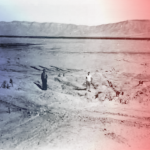 The U.S. bombed the Japanese cities of Hiroshima and Nagasaki 75 years ago this month. Although nuclear weapons haven’t been used in combat since, they continue to proliferate across the globe. This week, two activists from New Mexico explain the lesser known costs of the production of nuclear weapons…
The U.S. bombed the Japanese cities of Hiroshima and Nagasaki 75 years ago this month. Although nuclear weapons haven’t been used in combat since, they continue to proliferate across the globe. This week, two activists from New Mexico explain the lesser known costs of the production of nuclear weapons…
Continue reading
75th Anniversary Hiroshima Day Online Commemoration
REMEMBERING HIROSHIMA: This Hiroshima survivor returned to the site of the atomic bombing 75 years later.
Hiroshima to a Healthy Tomorrow: Embracing Our Common Humanity in a Virtual Rally
|
|
OREPA challenges NNSA’s “Final Supplement Analysis.”
The Oak Ridge Environmental Peace Alliance, along with Nuclear Watch New Mexico, has challenged the National Nuclear Security Administration’s latest justification for the Uranium Processing Facility bomb plant under construction at the Y-12 National Security Complex in Oak Ridge, Tennessee. In a letter to the Secretary of Energy and the Administrator of the NNSA, OREPA and NWNM pointed out that the Final Supplement Analysis, released in July, falls far short of the “hard look” required by the National Environmental Policy Act.
See OREPA Comments
The Final Supplement Analysis is NNSA’s attempt to comply with the order of the federal court in Knoxville, Tennessee. The court, in September of last year, ruled in favor of OREPA, NWNM, the Natural Resources Defense Council and four individual plaintiffs who argued that NNSA is in violation of NEPA, the law that requires federal agencies to consider the environmental impacts of their actions.
SEE ALSO:
[ILLINOIS] ComEd, Madigan Sued for $450M in Racketeering Suit
Illinois electric customers filed a federal civil racketeering lawsuit against ComEd and state House Speaker Michael Madigan, seeking more than $450 million in damages.
Breaking news update: Today, August 10, a putative class of Commonwealth Edison customers filed a civil racketeering lawsuit against Illinois Speaker of the House Michael Madigan, Commonwealth Edison Company (“ComEd”), ComEd’s parent Exelon Corporation, and several other defendants. Read all the details here.
BY: Michael Yoder | rtoinsider.com
The recent Illinois lobbying corruption scandal involving Exelon Corporation, its subsidiary Commonwealth Edison and Democratic House Speaker, Michael Madigan, demonstrates the extent to which nuclear “power” is about more than electrons.
The FBI arrests of the Ohio House Speaker and five others in a $60 million bribery/corruption scheme; the $10 billion Exelon nuclear bailout in New York; the questionable circumstances surrounding Exelon’s 2016 PepCo merger; and the South Carolina $9 billion SCANA fraud case, suggest that this may be a national pandemic.
DARK CIRCLE: The Sundance Grand Prize-winning classic doc about the dangers of the atomic age – newly restored!
Dark Circle – Official Trailer from First Run Features on Vimeo.
It’s been 75 years this month since the start of the Atomic Age, with the U.S. nuclear bombing of Hiroshima and Nagasaki killing hundreds of thousands of civilians, but its trail of destruction has never ended.
Public Interest Group Requests DOE Prepare “Programmatic Environmental Impact Statement” on Plutonium Disposition, in Support of Recommendation by National Academies of Sciences Pane
Plutonium Disposition via “Dilute & Dispose” to Bring at Least 22.5 Metric Tons More of Plutonium to Savannah River Site, On Top of 11.5 MT of Pu Already at SRS, Must Not be Stranded if Project Changes
Link to SRS Watch’s August 11 Letter to DOE on Plutonium Disposition and Need for PEIS
Savannah River Site Watch
https://srswatch.org/
Columbia, South Carolina
For immediate Release
August 12, 2020
Contact: Tom Clements, Director, SRS Watch, tel. 803-834-3084, cell 803-240-7268
Columbia, SC – The U.S. Department of Energy must prepare an overarching environmental analysis of slow-moving plans to process and dispose of surplus weapons plutonium at Savannah River Site and other DOE sites, according to a request made by Savanna River Site Watch, a public interest group providing oversight of SRS and DOE.
The August 11, 2020 letter to key DOE officials highlights reasons for preparation of a “Programmatic Environmental Impact Statements” (PEIS) on plutonium disposition and affirmed support for a recent recommendation by a panel of the National Academies of Sciences (NAS). A PEIS, prepared under the National Environmental Policy Act, would review the need for the project, assess DOE system-wide plutonium-disposition impacts and would analyze various sites to be utilized, including SRS, Los Alamos National Lab in New Mexico and the Pantex site in Texas (where more than 15,000 plutonium pits removed from weapons are stored).
New Mexico is still waiting for justice 75 years since the Manhattan Project
The state also faces coronavirus on this anniversary.
BY: Bernice Zamora Gutierrez & Paul Lopez Pino | thehill.com
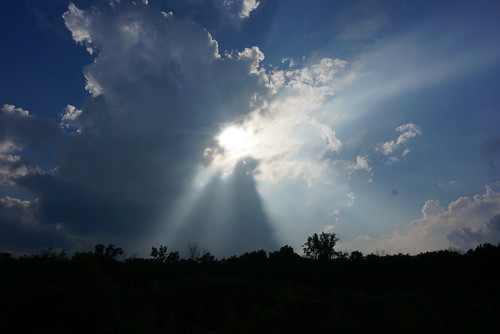
While our nation struggles to survive the COVID-19 pandemic, New Mexicans are already engaged in a deadly health crisis that has cost the lives of thousands of our beloved family and community members for the past 75 years. This crisis is the overexposure to radiation from the world’s first nuclear bomb detonation at Trinity Site in south central New Mexico on July 16, 1945. In the process it made many New Mexicans the first “Downwinder” communities exposed to radiation from nuclear weapons. The Trinity test in New Mexico was followed by the bombing of Hiroshima and Nagasaki three weeks later and we are all memorializing our dead on this 75th anniversary of the nuclear age. And just as the country is waiting for a pandemic recovery plan, New Mexicans are still waiting to be included in the Radiation Exposure Compensation Act (RECA) found in U.S. House Bill 3783.
Obscure agency writing off state politician’s debt
““…Romero and various board members charged taxpayers for lunches in and around Santa Fe. These meals for a select group in no way furthered the public interest. They only benefited coalition insiders.”
BY: Milan Simonich | santafenewmexican.com
You miss a few payments on the $7,800 you owe on your car. A repo agent will take away your ride and your pride while the neighbors watch.
You fail to make payments on a years-old $7,800 credit card bill. The lender will make certain you suffer from the worry of being sued. All the while your debt will balloon with interest charges and late fees.
That’s the real world. Life isn’t as hard in the echelon of state Rep. Andrea Romero and her former employer, the Regional Coalition of LANL Communities.
The coalition’s board claims Romero still owes it $7,800 for impermissible expenses accrued during her tenure as its executive director from March 2016 to February 2018. It asked Romero in May to pay the bill.
The reason we haven’t had nuclear disasters isn’t careful planning. It’s luck.

“Betting on another half-century with nuclear weapons, but with no new nuclear explosions, is not betting on succeeding twice at a game of control after a first victory. It’s betting our luck won’t run out in the future — simply because it hasn’t run out yet.”
The reason we haven’t had nuclear disasters isn’t careful planning. It’s luck. The alarming role of good fortune in the history o nuclear weapons | washingtonpost.com
Nuclear Power goes South in South Carolina
“It looks like crime might well pay after all.”
That was the weary and only slightly tongue-in-cheek conclusion drawn by longtime anti-nuclear campaigner, Tom Clements recently, after a former South Carolina nuclear utility executive pled guilty to fraud in federal court.
BY: Linda Pentz Gunter | beyondnuclear.org
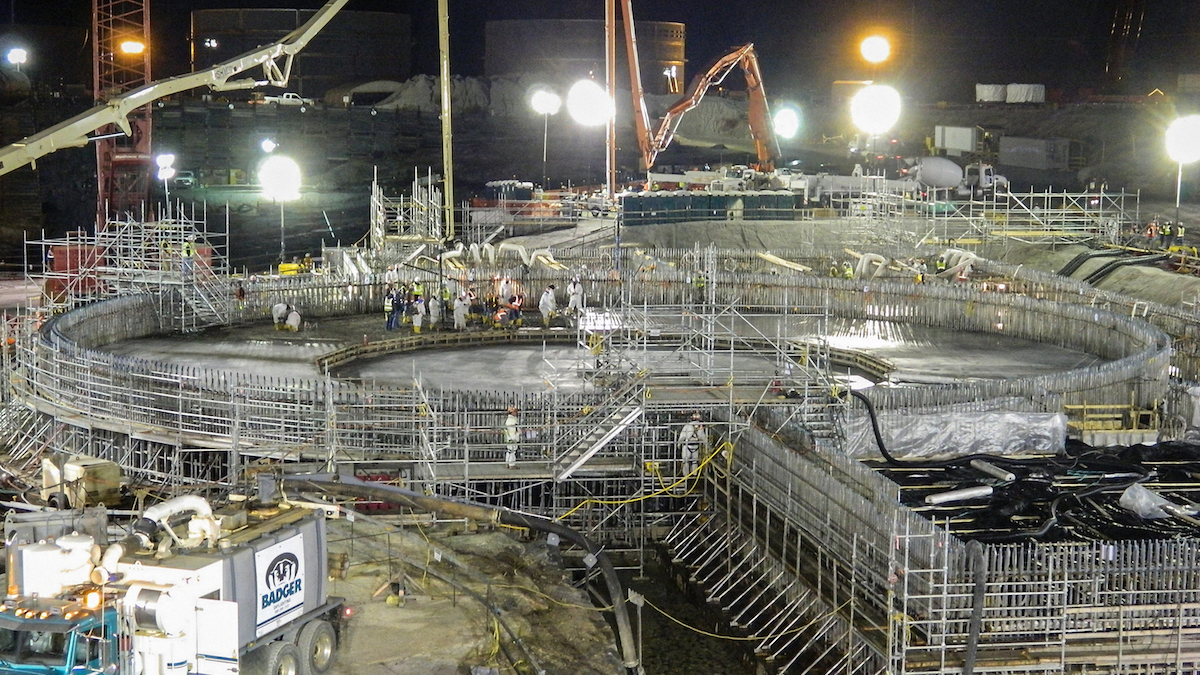
Clements is the director of Savannah River Site Watch, but his activism has, for decades, extended well beyond the perimeter of that vast nuclear site.
For years, Clements and others have followed — and attempted to stand in the way of — the forced march of South Carolina ratepayers toward nuclear fiasco. When it finally unraveled in late July, there was only cautious cause for celebration.
On July 23, Stephen Byrne, the former COO of SCANA, the South Carolina utility originally in charge of the construction of two new nuclear reactors in the state, pled guilty in a massive nuclear conspiracy that defrauded ratepayers, deceived regulators and misled shareholders.
Hiroshima survivor Dr. Hideko Tamura Snider, August 9, 2020
On August 9, 2020, Dr. Hideko Tamura Snider, author of “One Sunny Day” and “When A Peace Tree Blooms,” joined WILPF US Disarm/End Wars Committee and #HiroshimaNagasaki75 in describing her experiences before, during and after the Hiroshima bomb, and appealing to us all, “I depend on all of your energy, please continue what you are doing to rule out violent means, especially this inhumane, horrible weapon…. We are not barbarians, we are humans, and let us be truly and fully human….”
https://youtu.be/KYzuoGuqg34
75th Anniversary Timeline webinars at the WILPF US Disarm Committee YouTube channel – https://bit.ly/wilpfus-disarmyoutube
Jay Coghlan on The Richard Eeds Show August 3, 2020
The Richard Eeds Show. 8/3 – Jay Coghlan of Nuclear Watch New Mexico on The Event Commemorating the 75th Anniversary of the Bombing of Hiroshima.
Anti-nuclear protests at Kings Bay
“Our mission is to stop the arms race…it’s a security risk and phenomenally expensive. This has become a business model and it’s deadly.” – Glenn Carroll, coordinator of Nuclear Watch South
By: GORDON JACKSON / thebrunswicknews.com
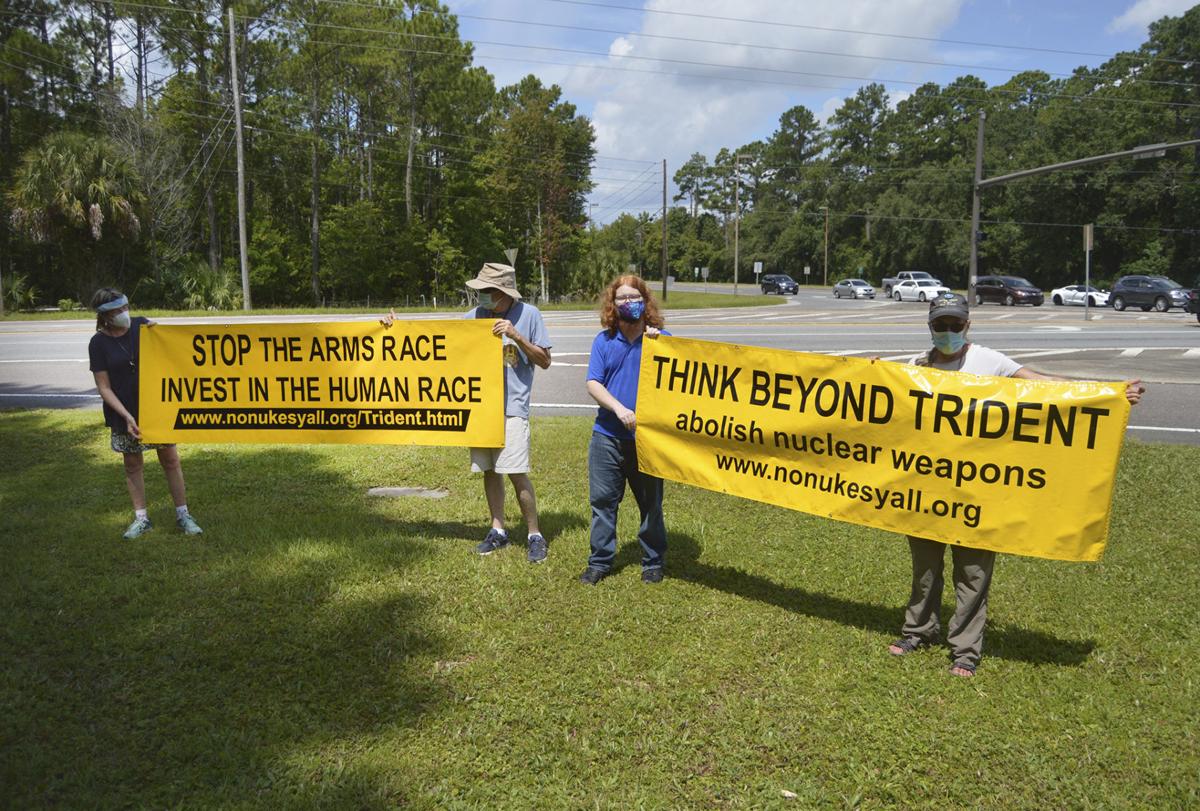
ST. MARYS / Organizers of an annual protest against nuclear weapons at Naval Submarine Base Kings Bay expected a large crowd to commemorate the 75th anniversary of the first atomic bomb dropped on Hiroshima, Japan, to help hasten the end of World War II.
Five people ended up standing outside a base gate Thursday holding signs with anti-nuclear weapons messages.
Glenn Carroll, coordinator of Nuclear Watch South, said the ongoing COVID-19 pandemic compelled many who were planning to attend to stay home for health concerns. But Carroll said her trip from Atlanta to join others with concerns about nuclear weapons Thursday was worth the time.
How New Tech Raises the Risk of Nuclear War
75 years after Hiroshima and Nagasaki, some experts believe the risk of the use of a nuclear weapon is as high now as it has been since the Cuban missile crisis.
BY: BRYAN WELSH | axios.com
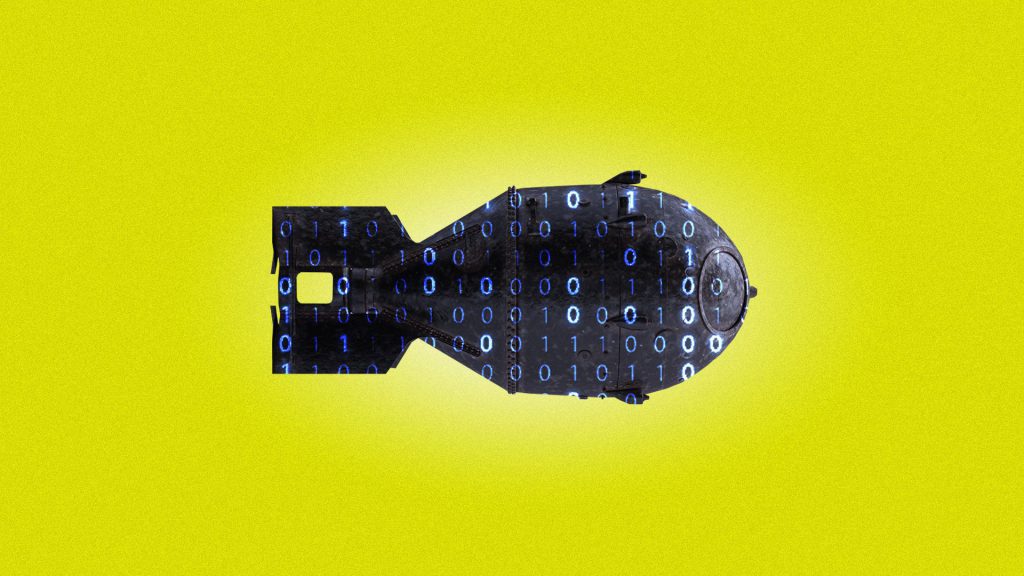
The big picture: Nuclear war remains the single greatest present threat to humanity — and one that is poised to grow as emerging technologies, like much faster missiles, cyber warfare and artificial intelligence, upset an already precarious nuclear balance.
What’s happening: A mix of shifting geopolitical tensions and technological change is upsetting a decades-long state of strategic stability around nuclear weapons.
- Strategic stability is when no country has an incentive to launch a first nuclear strike, knowing that doing so would inevitably lead to a catastrophic response. It’s the “mutual” in “mutually assured destruction.”
- Arms control deals like the Intermediate-Range Nuclear Forces Treaty are collapsing, while faster hypersonic missiles are shrinking the already brief minutes available to decide how and whether to respond to a potential nuclear attack, meaning “the possibilities of a miscalculation are unfortunately higher than they have been in a long, long time,” says former Energy Secretary Ernest Moniz.
- As concerning as rising tensions are between the U.S. and Russia, or between the U.S. and a more assertive China, experts worry even more about the destabilizing effect of emerging technologies like cyber warfare and AI.
- “The black box of AI in the future of war makes it almost inherently unpredictable,” says P.W. Singer, a strategist at New America and author of “Burn-In” — and unpredictability is anathema to a nuclear balance held in place by predictability.
2019
Gov. Gordon Open to Nuclear Waste Storage
Gov. Mark Gordon says he is open to Wyoming pursuing a nuclear waste storage facility though he doesn’t personally believe it’s the best industry for the state.
ARTICLE BY TOM COULTER | wyomingnews.com
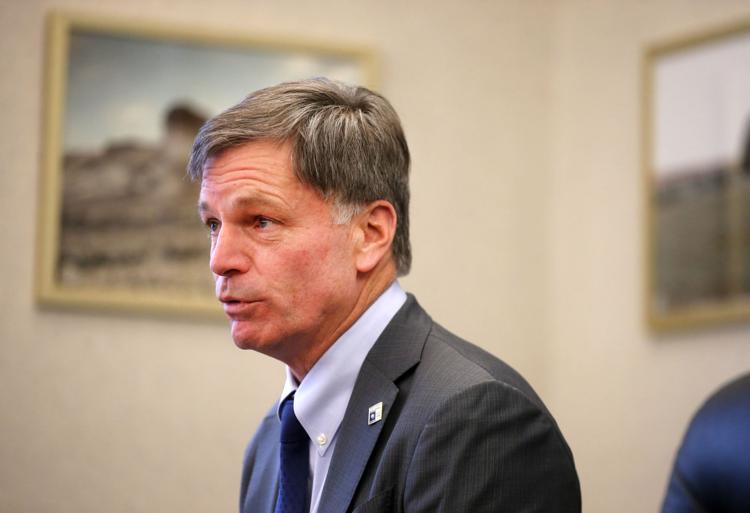
CHEYENNE – Gov. Mark Gordon said last week he could still be convinced to pursue a nuclear waste storage program that will be considered Tuesday in a legislative committee meeting.
During a meeting Monday with the Wyoming Tribune Eagle’s editorial board, Gordon said he would wait to see what the Wyoming Legislature finds in its studies.
“I don’t think it’s the best industry for Wyoming,” Gordon said. “But I would say this emphatically: If there is a good reason to do it, and we have adequate safeguards, though personally I may not feel it’s the best industry for Wyoming, I’m not going to stand in its way.”
During the second day of its meeting next week in Casper, the Legislature’s Joint Minerals, Business and Economic Development Interim Committee will consider a bill authorizing the governor to negotiate with the U.S. Department of Energy to store spent nuclear fuel rods within the state.
Russia says it’s already too late to replace new START treaty
Last Major Nuclear Arms Pact Could Expire With No Replacement, Russia Says
The treaty, disliked by President Trump, will run out in 14 months — and there is too little time to hammer out a new one, a Russian official said.
ARTICLE BY TOM BALMFORTH | reuters.com
MOSCOW (Reuters) – Russia said on Friday there was no longer enough time left for Moscow and Washington to negotiate a full-fledged replacement for the New START nuclear arms control treaty before it expires in February 2021.
The New START accord is the last major nuclear arms control treaty between the world’s two biggest nuclear powers and limits the number of strategic nuclear warheads they can deploy.
The fate of the accord has been in the spotlight since Washington in August pulled out of another landmark strategic arms accord, the Intermediate-Range Nuclear Forces Treaty (INF), citing violations by Russia that Moscow denies.
“It’s already obvious that with the time that is left… we will not be able to work out a full-fledged replacement document,” Vladimir Leontyev, a foreign ministry official, was quoted as saying by Interfax news agency.
The treaty can be extended by mutual agreement, but the prospect of that happening is unclear as Washington is not moving quickly and Moscow would need at least half a year to implement any extension agreement, Leontyev said. There was no immediate reaction from Washington to his comments.
The Possibility of Nuclear War Between India and Pakistan Is Greater Than Experts Would Prefer
ARTICLE BY KYLE MIZOKAMI | nationalinterest.org

Experts believe Pakistan’s nuclear stockpile is steadily growing. In 1998, the stockpile was estimated at five to twenty-five devices, depending on how much enriched uranium each bomb required. Today Pakistan is estimated to have an arsenal of 110 to 130 nuclear bombs. In 2015 the Carnegie Endowment for International Peace and the Stimson Center estimated Pakistan’s bomb-making capability at twenty devices annually, which on top of the existing stockpile meant Pakistan could quickly become the third-largest nuclear power in the world.
Pakistan and India are clearly in the midst of a nuclear arms race that could, in relative terms, lead to absurdly high nuclear stockpiles reminiscent of the Cold War. It is clear that an arms-control agreement for the subcontinent is desperately needed.
Iran launches more advanced machines to speed up nuclear enrichment: official
Tehran has rejected the Trump administration’s demand that a a new deal imposing stricter limits on its nuclear capacity as well as curbs on its ballistic missile programme and on its regional behaviour.
ARTICLE BY PARISA HAFEZI | reuters.com

DUBAI (Reuters) – Iran said on Monday it had launched a new batch of advanced centrifuges to accelerate uranium enrichment, further reducing compliance with the 2015 nuclear deal following the withdrawal of its arch-foe the United States. Iran has gradually shed commitments made under the deal with world powers since being hit with renewed U.S. sanctions that have crippled its oil exports. Germany said on Monday Iran’s announced roll-out of modernised centrifuges jeopardises the accord and called on Tehran to return to it.
Responding to Washington’s “maximum pressure” campaign, Iran has bypassed the restrictions of the deal step-by-step – including by breaching both its cap on stockpiled enriched uranium and on the level of enrichment.
Tehran, however, has left room for diplomacy by saying that talks are possible if Washington lifts all the sanctions and itself returns to the nuclear deal.
“If they (Washington) return to their commitments, we also will go back to our commitments,” Salehi said, adding that “Iran is ready to fully implement the deal if its rights are respected”.
What Does Science Say About the Need for Nuclear? Not Necessary.
ARTICLE BY JESSICA MCDONALD | factcheck.org
Ryan Jones, an expert in electricity systems and a co-founder of Evolved Energy Research, a consulting company that models low-carbon transitions, agreed. “Anyone who says that nuclear is 100% necessary on a technical basis, I would claim, just hasn’t looked at the alternatives in enough detail,” he said in an email.
Most experts FactCheck.org contacted, including those who think nuclear power should remain an option, said that from a technical perspective, nuclear is not needed to decarbonize the grid.
The Air Force Has Stopped Using 8-Inch Floppy Disks for Missile Command
The US nuclear forces’ Dr. Strangelove-era messaging system finally got rid of its floppy disks
BY: VALERIE INSINNA | c4isrnet.com
OFFUTT AIR FORCE BASE, Neb. — In 2014, “60 Minutes” made famous the 8-inch floppy disks used by one antiquated Air Force computer system that, in a crisis, could receive an order from the president to launch nuclear missiles from silos across the United States.

But no more. At long last, that system, the Strategic Automated Command and Control System or SACCS, has dumped the floppy disk, moving to a “highly secure solid state digital storage solution” this past June, said Lt. Col. Jason Rossi, commander of the Air Force’s 595th Strategic Communications Squadron.
The communication system which keeps the president in touch with the nuclear triad during a crisis will now be the responsibility of the head of U.S. Strategic Command.
Russia test-fires missile from new nuclear-powered submarine
Russia has successfully test-fired an intercontinental ballistic missile from its latest nuclear-powered submarine, the country’s defence ministry says.
BY: JONATHAN MARCUS | bbc.com
Footage captured overnight shows the release of the so-called Bulava missile from an underwater position in the White Sea, the ministry said.
It was fired from Russia’s new Prince Vladimir submarine and was reported to have travelled thousands of kilometres.
The submarine is expected to be operational by the end of the year.
Completed in the early hours of Thursday, the Bulava missile launch – the first of its kind from the Prince Vladimir – was one of many weapons tests expected to take place in the coming weeks.
2018
New Los Alamos lab manager Triad will pay Gross Receipts Tax
New Los Alamos lab manager Triad will pay GRT, official says
By Andy Stiny | astiny@sfnewmexican.com
Aug 22, 2018 Updated 16 hrs ago
A representative of Triad National Security LLC, which takes over management of Los Alamos National Laboratory in November, said Wednesday the consortium will pay gross receipts taxes, easing concerns of local officials about losing millions of dollars in revenue.
Scott Sudduth, assistant vice chancellor with the Office of Federal Relations for the Texas A&M University system, told an audience of about 50 community members during a meeting in Los Alamos that the New Mexico Taxation and Revenue Department responded to a recent inquiry from Triad by saying that “it is their view that the gross receipts tax does apply to Triad.”
Los Alamos County officials had said previously that if Triad were deemed to have nonprofit status, the county estimated it could lose $21 million annually and the state $23 million in gross receipts tax revenues, according to published reports.
Citizens Oppose Plans For New Mexico Nuclear Waste Dump
Citizens Oppose New Mexico Nuke Dump
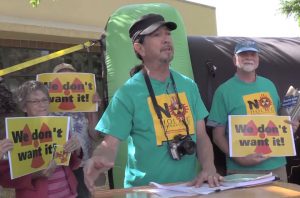
“We Don’t Want It!”
The Nuclear Waste Policy Act of 2018, HR 3053, known as the Shimkus Bill, has passed the House on its way to the Senate.
It calls for restarting the failed Yucca Mountain Project in Nevada, and establishing a system of Consolidated Interim Storage (CIS) sites for radioactive waste around the country until Yucca is operational.
First on the list of possible ‘temporary’ CIS dumps is a site proposed by Holtec International and the local Eddy-Lea Alliance just outside Hobbs, New Mexico. Its just over the border from Andrews, Co., Texas – where another high level nuke waste dump is also proposed.
Proponents tout it as an economic boon. Opponents see as it a public health and environmental disaster.
Planned to eventually hold more metric tons of waste than Yucca itself will be designed for, the Hobbs site could well become America’s de facto national dump site, if Yucca never gets built.
At a recent series of Nuclear Regulatory Commission community meetings on the proposed site, opposition was strong from many of New Mexico and Texas public sectors.
A press conference by local citizens laid out their views.
“We Don’t Want It!” Halt Holtec campaign continues. Opposition to proposed nuke dump is strong and growing.
State could block proposed nuclear storage site near Carlsbad
State could block nuclear storage site near Carlsbad even if federally licensed
By Adrian C. Hedden / Carlsbad Current-Argus, N.M. (TNS)
State lawmakers maintained they will have a say in a proposed facility to store high-level nuclear waste near Carlsbad and Hobbs, despite an opinion issued by New Mexico Attorney General Hector Balderas suggesting New Mexico will have a limited role in licensing the project.
New Mexico Sen. Jeff Steinborn (D-36), who chairs the New Mexico Radioactive and Hazardous Waste Committee said Balderas’ opinion was informative but did not preclude lawmakers from preventing the facility from operating.
The committee convened in May to study the project proposed by New Jersey-based Holtec International, and held its third meeting on Wednesday at University of New Mexico-Los Alamos.
Opposed to the project, Steinborn said state lawmakers owe their constituents a full review of the proposal.
“I think it’s kind of a troubling deficiency in the government if the state doesn’t have to give consent to have something like this foisted upon it,” he said. “The State of New Mexico owes it to the people to look at every aspect of it.”
Katzman Tells Utilities Board RDX Never Detected In County Water Supply Wells
Danny Katzman gave his punchline first Tuesday evening at the Nov. 20 Los Alamos County Board of Public Utilities meeting where he gave a presentation on Royal Demolition Explosive (RDX) contamination from Los Alamos National Laboratory. Katzman is the Technical Programs Manager for N3B, the Lab’s legacy waste cleanup contractor.
By: MAIRE O’NEILL | losalamosreporter.com November 24, 2018
“RDX has never been detected in the County’s water supply wells. It’s nowhere near the County water supply wells and it’s every intent of the Department of Energy and N3B to ensure that never becomes the case,” Katzman said.
In introducing Katzman, Utilities Manager Tim Glasco said DOE revealed in a meeting with the County Council as part of an overall presentation on groundwater protection and other environmental activities going on at LANL that they were following an RDX contamination vent out at the Lab. He said there was some citizen concern and concern by some County Council members about the extent of that contamination and whether or not it was a threat, specifically to the County’s drinking water wells. Glasco said he met with DOE Environmental Management and N3B and that it became apparent that “it’s a fairly complex situation out there” so he requested that N3B make a presentation to the board.
Trinity site cancer study expected to finish in 2019
- By Russell Contreras | Associated Press
- Updated
ALBUQUERQUE — A long-anticipated study into the cancer risks of New Mexico residents living near the site of the world’s first atomic bomb test likely will be published in 2019, the National Cancer Institute announced.
Institute spokesman Michael Levin told the Associated Press that researchers are examining data on diet and radiation exposure on residents who lived near the World War II-era Trinity test site, and scientists expect to finish the study by early next year.
Federal health officials agree radioactive waste in St. Louis area may be linked to cancer
The federal government confirms some people in the St. Louis area may have a higher risk of getting cancer. A recent health report found some residents who grew up in areas contaminated by radioactive waste decades ago may have increased risk for bone and lung cancers, among other types of the disease. The assessment was conducted by the Agency for Toxic Substances and Disease Registry, a branch of the U.S. Centers for Disease Control and Prevention.
As CBS News correspondent Anna Werner reports, the situation is not unique to St. Louis because it’s connected to America’s development of its nuclear weapons program decades ago. Radioactive wastes persist in soils, and many believe that’s why they or a loved one developed cancer. Now for the first time, federal health officials agree, on the record, that’s a real possibility.
Read More
Hiroshima’s Children
With a gift of art supplies, children who survived the bombings drew visions of joy
Pictures from a Hiroshima Schoolyard is a 52-minute documentary produced by Shizumi Shigeto Manale and written and directed by Bryan Leichhardt.
NMED Announces Comment Period For WIPP Permit Modification to Change Waste Volume Accounting
In an example of Now-You-See-It-Now-You-Don’t, the NM Environment Department (NMED) is proposing to change their method of measuring waste emplaced into the underground at WIPP. This would would allow 30% more waste into WIPP than is currently allowed. This sleight of hand would be accomplished by not counting the outer-most container of waste packages in the future. This proposal is one piece of a larger plan to bring more waste to WIPP. New Mexicans have already taken enough of the nation”s radioactive waste. More waste increases the the chance of serious accidents leading to dangerous contamination.
Comments are currently due September 20, 2018 at 5pm, but this deadline ridiculously short. Please join us when we ask for an extension.
We will soon post some sample comments and will give updates as soon as NMED posts the Permit Modification online.
See the Notice here – WIPP Class 3 VOR Notice
Dr. Bruce Blair
April 4, 2018:
“Europe has become a nuclear flashpoint where tensions could easily escalate to the level of a nuclear confrontation… Both NATO and Russia are engaging in ‘terrifying nuclear brinkmanship’… that increases the risk of the actual use of nuclear weapons – by design or by accident.”
The B61-12 in Europe: A German View
“American nuclear bombs are still stationed in Europe. In Germany alone, up to 20 B-61 weapons are stored on a German airbase in the village of *****.
The German government has said on numerous occasions it would like to see those weapons removed, but there is no great chance of that happening anytime soon. Instead, the weapons are expected to be upgraded with enhanced military capabilities.”
(Spiegel Online, “Nuclear Arsenal: US To Turn Old Bombs Into All-Purpose Weapons”, Nov 6, 2013)
2017
Oppose Plans To Bring ALL the Nation’s Commercial Reactor Waste To New Mexico!
Oppose Plans To Bring ALL the Nation’s Commercial Reactor Waste To New Mexico!
Contact your New Mexico U.S. Representative ASAP!
Contact Information and Sample Request are Below
Please vote against Shimkus Nuclear Waste Bill
U.S. Rep. John Shimkus (Republican-Illinois) succeeded in rushing his high-level radioactive waste dump/centralized interim storage facility (including parts targeted at New Mexico!) legislation past the Environment and the Economy Subcommittee he chairs.
Title I of the bill provides that the DOE Secretary could enter into agreements to pay for private storage facilities, such as the Holtec site in Eddy and Lea Counties in New Mexico. That would change the existing law’s prohibitions of such DOE action, which have been in place for 35 years.
If a centralized interim storage facility, or “de facto permanent parking lot dump,” is opened at the Eddy-Lea [Counties] Energy Alliance (ELEA) site near the Waste Isolation Pilot Plant, incredibly large numbers of high-level radioactive shipments could come to NM. ELEA is a scheme being promoted by the New Jersey-based Holtec International irradiated nuclear fuel shipping/storage container company. Holtec submitted its application to the Nuclear Regulatory Commission (NRC) for a 40-year license to store 100,000 metric tons of commercial spent fuel. There are currently 80,000 metric tons stored at reactors around the country.
ALL the commercial spent fuel in the country could end up in New Mexico, which has no commercial reactors and did not generate any of this waste.
Please note that Ben Ray Luján (Democrat-New Mexico-3rd U.S. Congressional District) <http://lujan.house.gov/> serves on the U.S. House Energy & Commerce Committee. If you reside in his district, it is especially important that you contact him ASAP, urging his leadership in opposing this bill! And please urge your friends, neighbors, family, etc. to do the same!
If you reside elsewhere in New Mexico, please contact your own U.S. Representative. This bill will impact the entire state of New Mexico — in fact, it will impact the entire country!
BEN RAY LUJÁN (Democrat-NM’s 3rd U.S. Congressional District)
Email <https://lujan.house.gov/email-me/>
Washington, D.C. office direct phone number: (202) 225-6190
Santa Fe Office, Ph: (505) 984-8950
MICHELLE LUJAN GRISHAM (Democrat-NM’s 1st U.S. Congressional District)
Email Link <https://lujangrisham.house.gov/contact>
Washington, D.C. Office: Ph:(202) 225-6316
Albuquerque Office: Ph: (505) 346-6781
U.S. Rep. STEVE PEARCE (Republican-NM’s 2nd U.S. Congressional District)
Washington, D.C. Office: Phone: (202) 225-2365
Alamogordo Office: Phone: 855-4-PEARCE
SAMPLE LETTER
Subject: Please vote against Shimkus Nuclear Waste Bill
Please convey to Rep. Lujan our strong opposition to the Shimkus unnumbered nuclear waste bill that was reported by the Environment Subcommittee of E&C on June 15. We ask that he vote against the bill during full committee markup. We also urge him to speak against the bill and voice New Mexico’s objections to being targeted for ALL of the nation’s commercial spent nuclear fuel.
Title I of the bill provides that the DOE Secretary could enter into agreements to pay for private storage facilities, such as the Holtec site in New Mexico and Waste Control Specialists in Texas. That would change the existing law’s prohibitions of such DOE action, which have been in place for 35 years.
Such a change is unwarranted because spent fuel can stay at the existing reactor storage sites, would allow for unnecessary and dangerous transportation across the nation, and supports a false premise that New Mexicans support such a facility. As the Congressman knows, that is not true. New Mexicans opposed spent nuclear fuel and high-level waste coming to WIPP, which resulted in the prohibition of such waste in the 1992 WIPP Land Withdrawal Act.
New Mexicans and many tribal members opposed the private storage facility proposed on the Mescalero Apache Reservation in the 1990s. New Mexicans continue to oppose bringing spent fuel to the state. The Holtec license application to the Nuclear Regulatory Commission states that the site would be designed for 100,000 metric tons of commercial spent fuel. That’s ALL of the spent fuel that currently exists (less than 80,000 metric tons), plus decades more of spent fuel production at nuclear power plants.
The bill also has many objectionable provisions related to Yucca Mountain, western water and land rights, reducing environmental protections, among many other things.
Thus, the bill’s many flaws make it unworkable.
Please vote against the bill during markup.
Thank you very much for your consideration.
Your name
City
Zip Code
Some Background on Plutonium Pit Production at the Los Alamos Lab
Some Background on Plutonium Pit Production at the Los Alamos Lab
The Washington Post has published the first in a series of articles on nuclear safety lapses in plutonium pit production at the Los Alamos Lab. Plutonium pits are the fissile cores of nuclear weapons that when imploded initiate the thermonuclear detonation of modern weapons.
- The former production site, the Rocky Flats Plant near Denver, was shut down by a 1989 FBI raid investigating environmental crimes. A special grand jury indicted both DOE officials and the contractor, but its report was sealed by a federal judge at the urging of the local federal attorney general. It was only by sheer luck that a major plutonium fire on Mother’s Day 1969 didn’t contaminate Denver with highly carcinogenic plutonium.
- Senior DOE officials promised New Mexicans 20 years ago that serious lessons were learned from the Rocky Flats Plant and re-established plutonium pit production at the Los Alamos National Laboratory (LANL) would always be safe. Since then the Los Alamos Lab has spent billions of taxpayers’ money on plutonium pit production, but as the Washington Post article documents still can’t do it safely.
- As the Washington Post article reports, a serious nuclear criticality incident was narrowly averted in July 2011, which resulted in the three-year shut down of LANL’s main plutonium facility. Nevertheless, according to the FY 2011 LANL Performance Evaluation Report, the Lab contractor was paid $50 million in pure profit for that year. These Performance Evaluation Reports are the report card whereby the government determines how much the taxpayer will pay nuclear weapons contractors. The government denied taxpayer access to these reports until NukeWatch successfully sued for them.
- A radioactive waste barrel improperly prepared by LANL ruptured underground at the Waste Isolation Pilot Plant (WIPP), shutting down that multi-billion dollar facility for nearly three years. Radioactive waste disposal at WIPP will remain constrained for years, raising the question of where future LANL bomb-making wastes will go.
- Plutonium facilities at LANL are supposed to be designed to withstand a serious earthquake that is supposed to occur only once in every 10,000 years. The last serious earthquake near the Lab is believed to have occurred 11,500 years ago. Although there is no exact linear correlation, LANL is in a sense “overdue” for a serious seismic event given its numerous geologic faults.
- Congress has legislated a requirement that the Los Alamos Lab expand plutonium pit production, regardless of the technical needs of the stockpile. That requirement was drafted by professional staff on the Strategic Forces Subcommittee of the House Armed Services Committee, one of whom was originally from the Sandia nuclear weapons lab. That the existing stockpile doesn’t need pit production is demonstrated by the fact that none has been scheduled since LANL caught up with 29 W88 pits that were stopped when the Rocky Flats Plant was shut down.
- At NukeWatch’s request former senator Jeff Bingaman (D-NM) required an independent study of the lifetimes of pits. The expert conclusion was that plutonium pits last at least a century, more than double government estimates (the oldest pits in the stockpile are now around 45 years old). Moreover, there are some 15,000 existing plutonium pits stored at the Pantex Plant near Amarillo, TX.
- Future plutonium pit production is for a new so called “Interoperable Warhead” that is suppose to function both as a land-based ICBM and sub-launched nuclear warhead. The nuclear weapons labs are pushing this $13 billion make-work project that the Navy doesn’t want. Ironically, new-design pits for the Interoperable Warhead may hurt national security because they cannot be tested in a full-scale nuclear weapons test, or alternatively testing them would have severe international proliferation consequences.
- Given all this, why expand plutonium pit production when apparently it can’t be done safely and may decrease, not increase, our national security? One strong reason is the huge contractor profits to be had under the one trillion dollar-plus “modernization” of the nuclear weapons stockpile and production complex initiated under Obama, which Trump promises to expand. Far from just “modernization”, existing nuclear weapons are being given new military capabilities despite denials at the highest levels of government.
- The directors of the Livermore, Sandia and Los Alamos nuclear weapons labs in truth wear two hats, the first as lab directors, the second as presidents of the for-profit limited liability corporations running the labs. This inherent conflict-of-interest that skews U.S. nuclear weapons policy should be brought to an end.
Jay Coghlan, NukeWatch Director, commented, “The New Mexican congressional delegation kowtows to the nuclear weapons industry in our state. I specifically call upon my two senators Tom Udall and Martin Heinrich to certify within this calendar year that future plutonium pit production at the Los Alamos Lab will be safe, or otherwise end their support for it.”
# # #
The Washington Post article is available at https://www.washingtonpost.com/world/national-security/safety-lapses-undermine-nuclear-warhead-work-at-los-alamos/2017/06/17/87f051ee-510d-11e7-b064-828ba60fbb98_story.html
The article is also being carried in The New Mexican at http://www.santafenewmexican.com/news/local_news/repeated-safety-lapses-hobble-lanl-s-work-on-u-s/article_f45dd72a-d6f6-580c-97af-8ffcb9fe8364.html
For more on expanded plutonium pit production please see https://nukewatch.org/facts/nwd/PitProductionFactSheet.pdf
Don’t trust what NNSA and LANL say
In direct response to the Center for Public Integrity’s first article, NNSA Administrator Frank Klotz broadcasted a strongly worded statement to national media. Among other things, Klotz categorically claimed that, “By late 2016, the (LANL) plutonium facility had resumed all operations that had been paused in 2013.” (Emphasis added)
This doesn’t square with these two weekly reports from the Defense Nuclear Facilities Safety Board:
Los Alamos Report for Week Ending September 9, 2016
Following successful closure of the corrective actions, LANL will have completed the revised scope of the formal restart project, restoring basic functionality to the facility¹s manufacturing and surveillance missions. An additional 18 readiness activities are planned for the next two years, including some new activities and some that were de-scoped from the formal restart project such as the aqueous chloride and nitrate operations.
Los Alamos Report for Week Ending December 30, 2016
Plutonium Facility personnel completed the revised scope of the restart project. Notably, several process deviations occurred in resumed operations prompting management to significantly change the material move procedure. The next significant readiness review is scheduled to occur in April 2017 for the aqueous chloride and americium oxide operations. – End –
This goes to show why the public can’t trust the truthfulness of anything the National Nuclear Security Administration and the Los Alamos Lab say. When they are a long ways from a touchdown, they move the goal posts (i.e., “de-scoping”) while collecting millions in taxpayers’ dollars.
Nuclear safety lapses in plutonium pit production at the Los Alamos Lab
The Washington Post has published the first in a series of articles on nuclear safety lapses in plutonium pit production at the Los Alamos Lab. Plutonium pits are the fissile cores of nuclear weapons that when imploded initiate the nuclear detonation. See https://www.washingtonpost.com/world/national-security/safety-lapses-undermine-nuclear-warhead-work-at-los-alamos/2017/06/17/87f051ee-510d-11e7-b064-828ba60fbb98_story.html
The article is also being carried in The New Mexican at http://www.santafenewmexican.com/news/local_news/repeated-safety-lapses-hobble-lanl-s-work-on-u-s/article_f45dd72a-d6f6-580c-97af-8ffcb9fe8364.html
I live in Santa Fe, NM and clearly remember senior DOE officials promising 20 years ago that serious lessons were learned from the Rocky Flats Plant and re-established plutonium pit production at the Los Alamos National Laboratory (LANL) would always be safe. Rocky Flats was shut down by a 1989 FBI raid investigating environmental crimes. A special grand jury indicted both DOE officials and the contractor, but its report was sealed by a federal judge at the urging of the local federal attorney general. It was only by sheer luck that a major plutonium fire on Mother’s Day 1969 didn’t contaminate Denver with highly carcinogenic plutonium (google the article The Day We Almost Lost Denver).
Since then the Los Alamos Lab has spent billions of taxpayers’ money on plutonium pit production, but still can’t do it safely. Moreover, as the article mentions, a radioactive waste barrel improperly prepared by LANL ruptured underground at the Waste Isolation Pilot Plant (WIPP), shutting down that multi-billion dollar facility for nearly three years. Radioactive waste disposal at WIPP will remain constrained for years, raising the question of where future LANL bomb-making wastes will go.
Congress in its infinite wisdom has legislated a requirement that the Los Alamos Lab expand plutonium pit production, regardless of the technical needs of the stockpile. That the existing stockpile doesn’t need pit production is demonstrated by the fact that none is scheduled. Future pit production is for a new so called “Interoperable Warhead” that is suppose to function both as a land-based ICBM and sub-launched nuclear warhead. The nuclear weapons labs are pushing this $13 billion make-work project that the Navy doesn’t want. Ironically, new-design pits for the Interoperable Warhead may hurt national security because they cannot be tested in a full-scale nuclear weapons test, or alternatively testing them would have severe international proliferation consequences.
At my request former senator Jeff Bingaman (D-NM) required an independent study of the lifetimes of pits. The expert conclusion was that plutonium pits last at least a century, more than double government estimates (the oldest pits in the stockpile are now around 45 years old). Moreover, there are some 15,000 existing plutonium pits stored at the Pantex Plant near Amarillo, TX.
Given all this, why expand plutonium pit production when apparently it can’t be done safely and may decrease, not increase, our national security? One strong reason is the huge contractor profits to be had under the one trillion dollar-plus “modernization” of the nuclear weapons stockpile and production complex initiated under Obama, which Trump promises to expand. Far from just “modernization”, existing nuclear weapons are being given new military capabilities despite denials at the highest levels of government. The directors of the Livermore, Sandia and Los Alamos nuclear weapons labs in truth wear two hats, the first as lab directors, the second as presidents of the for-profit limited liability corporations running the labs. This is inherent conflict-of-interest that skews U.S. nuclear weapons policy should be brought to an end.
The New Mexican congressional delegation kowtows to the nuclear weapons industry in my state. I specifically call upon my two senators Tom Udall and Martin Heinrich to certify within this calendar year that future plutonium pit production at the Los Alamos Lab will be safe, or otherwise end their support for it.
For more background on plutonium pit production at the Los Alamos Lab see https://nukewatch.org/facts/nwd/PitProductionFactSheet.pdf
Some Background on Plutonium Pit Production at the Los Alamos Lab
Santa Fe, NM
The Washington Post has published the first in a series of articles on nuclear safety lapses in plutonium pit production at the Los Alamos Lab. Plutonium pits are the fissile cores of nuclear weapons that when imploded initiate the thermonuclear detonation of modern weapons.
By the way, did you know? Plutonium facilities at LANL are, in principle, designed to withstand a serious earthquake of a degree expected to occur only once every 10,000 years. The last serious earthquake near the Lab is believed to have occurred 11,500 years ago.
Final Negotiations Begin on Nuclear Weapons Ban Treaty
Draft Nuclear Weapons Ban Treaty View/download PDF
An Open Letter from Scientists in Support of the UN Nuclear Weapons Negotiations
Selected Elements of a Treaty Prohibiting Nuclear Weapons
Statements and working papers to the conference
The International Association Of Lawyers Against Nuclear Arms is calling for a a prohibition on “threat of use”. (ref)
Unfold Zero, the World Future Council, Parliamentarians for Nuclear Non-Proliferation and Disarmament and the Basel Peace Office are calling for a prohibition on the financing of nuclear weapons production. (ref)
We have a dossier on the background and trajectory of this initiative, and we’ll keep it up to date with news and developments: Ban Treaty dossier.
For further in-depth coverage of these negotiations, see the Reaching Critical Will and ICANwebsites. Also note the ban treaty blog at ICAN for daily news and developments.
Mattis “Open To Rethinking” New ICBMs and Nuclear Cruise Missiles
Pressed by Sen. Dianne Feinstein, who opposes the planned nuclear cruise missile (LRSO), Defense Secretary Mattis told a Senate Budget Hearing June 14 he’s open to rethinking the triad, as well as the LRSO.
Mattis said he would be consulting with former Defense Secretary William Perry, who has advocated eliminating one leg of the triad by phasing out the land-based intercontinental ballistic missiles. Perry met with Mattis on the day of the hearing, and later tweeted, “Very wide ranging, candid, and productive discussion with Sec Def Mattis at the Pentagon today.”
Perry is also strongly opposed to developing new nuclear cruise missiles, which he says are “uniquely destabilizing” weapons, because an adversary cannot tell a conventional missile from a nuclear-armed version, risking miscalculation in a crisis.
“I register loud and clear the potential destabilizing view that some people see this weapon bringing and I’m taking that on board,” Mattis said. see the Washington Examiner
Note that both ICBMs and the nuclear cruise missiles – the two weapons systems most frequently seen by experts as unnecessary and dangerous, are Air Force systems, and that Heather Wilson, a long time pal of the weapons contractors, is now Secretary of the Air Force.
How to Deal With North Korea
There are no good options. But some are worse than others.
This is a detailed long-form report from Mark Bowden at The Atlantic. It’s well worth the read; – or you can listen to a sonorous voice patiently read the whole thing to you (recommended) via Soundcloud. The “no-good options”? Prevention (first strike); Turning the Screws; Decapitation; Acceptance.
Draft Nuclear Weapons Ban Treaty Released Today
(l.) Conference President Elayne Whyte of Costa Rica, and (r.) Tim Wright of ICAN
Lab Fire Highlights Ongoing LANL Waste Problems
The incident highlighted, once again, a pattern of consistent mismanagement in the maintenance and cleanup of some of the most dangerous materials on Earth.
This pattern of problems also has prompted the Defense Nuclear Facilities Safety Board to question whether the facility should continue to operate and handle increasing quantities of plutonium in coming years. On Friday, the board said it will hold a June 7 hearing in Santa Fe to question a number of experts about the lab’s ability to safely carry out future nuclear missions at PF-4 (the “plutonium building”)…
2016
Nuclear Watch NM Gives Notice of Intent to Sue Over Lack of Cleanup at the Los Alamos Lab
Nuclear Watch NM Gives Notice of Intent to Sue
Over Lack of Cleanup at the Los Alamos Lab
Nuclear Watch New Mexico has notified the Department of Energy (DOE) and the Los Alamos National Laboratory (LANL) that it will file a lawsuit over their failure to meet cleanup milestones under a “Consent Order” governed by the New Mexico Environment Department. Formal notice is required before a lawsuit can actually be filed, which NukeWatch intends to do within 60 days or less. The New Mexico Environmental Law Center is representing NukeWatch in this legal action to enforce cleanup at LANL.
Jay Coghlan, NukeWatch Executive Director, commented, “The nuclear weaponeers plan to spend a trillion dollars over the next 30 years completely rebuilding U.S. nuclear forces. Meanwhile, cleanup at the Los Alamos Lab, the birthplace of nuclear weapons, continues to be delayed, delayed, delayed. We are putting the weaponeers on notice that they have to cleanup their radioactive and toxic mess first before making another one for a nuclear weapons stockpile that is already bloated far beyond what we need. Real cleanup would be a win-win for New Mexicans, permanently protecting our water and environment while creating hundreds of high paying jobs.”
Last week Nuclear Watch NM broke a story on how LANL and DOE have formally given the green light for new underground facilities to expand the production of plutonium pits (the fissile triggers of modern H-bombs) from the currently approved level of 20 pits per year to 80. In all, upgrades to existing plutonium facilities at LANL and the construction of two underground “modules” that can be added to later for yet more production will cost at least $4 billion. The environmental impact statement for a previously proposed Walmart-sized plutonium facility (canceled because of costs that exploded up to $6.5 billion dollars) documented that not a single new Lab job would be created because it would simply relocate existing jobs. Full cleanup, on the other hand, would be labor intensive and create hundreds of high paying jobs for several decades.
Every year the estimated cost of nation-wide “environmental liabilities” from past nuclear weapons research and production, currently $298 billion, outpaces the annual levels of environmental restoration funding actually spent, even though those estimated liabilities don’t include full cleanup to begin with. At the same time, one multi-billion dollar DOE cleanup project after the other fails, for example the $13.5 billion Waste Treatment Plant at the Hanford nuclear reservation, the multi-billion dollar Waste Isolation Pilot Plant in southern New Mexico (closed because of a ruptured radioactive waste barrel from LANL), and the estimated $2.6 billion spent to date for incomplete cleanup at LANL. As an example of local impacts, during major stormwater events the City of Santa Fe has to close water diversion on the Rio Grande that can supply up to 15 million gallons per day of drinking water because of plutonium contamination in Los Alamos Canyon. Meanwhile, nation-wide, thousands of sick Cold War workers and downwinders from nuclear weapons tests await long delayed health benefits and compensation.
LANL is key to the trillion dollar rebuilding of nuclear forces as the premier nuclear weapons design lab and the nation’s sole production site for plutonium pit triggers, the most critical nuclear weapons components. Funding for DOE nuclear weapons programs is nearly double historic Cold War averages, with around $1.5 billion spent annually at LANL alone. In contrast, funding for Lab cleanup remains flat at around $185 million per year, with only approximately a third going to actual cleanup (one-third goes to pensions and another third to safeguarding improperly prepared radioactive waste barrels destined for the now-closed WIPP). New Mexico Environment Department (NMED) officials have publicly stated that around $250 million per year is needed for effective cleanup at LANL.
The 2005 Consent Order required DOE and LANL to investigate, characterize, and clean up hazardous and mixed radioactive contaminants from 70 years of nuclear weapons research and production. It also stipulated a detailed compliance schedule that the Lab was required to meet. Ironically, the last milestone, due December 6, 2015, required a report from LANL on how it successfully cleaned up Area G, its largest waste dump. However, real cleanup remains decades away, if ever. The Lab plans to “cap and cover” Area G, thereby creating a permanent nuclear waste dump in unlined pits and shafts, with an estimated 200,000 cubic yards of toxic and radioactive wastes buried above the regional groundwater aquifer, four miles uphill from the Rio Grande.
In the past the New Mexico Environment Department had repeatedly stated that it would release a revised Consent Order with new compliance dates before the end of 2015. Last November NMED Secretary Ryan Flynn said that a draft revised Consent Order would not be released until settlements were finalized over LANL violations of waste handling procedures that led to the closure of WIPP. Those settlement negotiations are still ongoing, leaving the Consent Order governing cleanup at the Lab in legal limbo.
Under typical hazardous waste handling permits, federal regulations require that an extension of a final compliance date include “an opportunity for a public hearing at which all interested persons shall be given a reasonable chance to submit data, views or arguments orally or in writing and to examine witnesses testifying at the hearing.” While the 2005 Consent Order is not a permit per se, it nevertheless explicitly incorporated the public process requirements of a federal hazardous waste permit. Therefore, Nuclear Watch New Mexico believes that any revised Consent Order requires an opportunity for meaningful public participation during its negotiation, leading to a public hearing should there be any unresolved issues, a position which so far NMED has opposed.
Scott Kovac, Nuclear Watch NM Research Director, said, “DOE, LANL and NMED have had four years to involve the public in revising Consent Order cleanup decisions and comnpliance dates at the Lab, but yet they seem to have ignored the final deadline. Northern New Mexicans want meaningful input into cleanup decisions at LANL. NukeWatch believes that a rigorous cleanup schedule must be stipulated from the beginning in any revised Consent Order, and that the Lab must be held accountable every step along the way for getting the necessary funding and doing the work on time. We insist upon meaningful public participation and dates certain for compliance milestones. Cleanup at the Los Alamos Lab cannot be open-ended or it will never be accomplished.”
# # #
Nuclear Watch New Mexico’s Notice of Intent to Sue is available at https://nukewatch.org/importantdocs/resources/NukeWatch-NM-NOI-to-DOE-and-LANS-20160120.pdf
Budget data are from the Department of Energy’s annual Congressional Budget Requests.
The current estimate of $298 billion to cleanup past nuclear weapons research and production comes from the DOE Agency Financial Report for Fiscal Year 2014. Even that figure does not come anywhere close to full and complete cleanup, but instead often involves “cap and cover” and leaving nuclear wastes permanently in place.
The quote concerning the need for a public hearing was incorporated into New Mexico state law NMSA 1978, §74-4-4.2(H) (2006).
NukeWatch Gives Notice of Intent to Sue Over Lack of Cleanup at Los Alamos
Santa Fe, NM.
Today, Nuclear Watch New Mexico notified the Department of Energy (DOE) and the Los Alamos National Laboratory (LANL) that it will file a lawsuit over their failure to meet cleanup milestones under a “Consent Order” governed by the New Mexico Environment Department. Formal notice is required before a lawsuit can actually be filed, which NukeWatch intends to do within 60 days or less. The New Mexico Environmental Law Center is representing NukeWatch in this legal action to enforce cleanup at LANL.
Jay Coghlan, NukeWatch Executive Director, commented,
“The nuclear weaponeers plan to spend a trillion dollars over the next 30 years completely rebuilding U.S. nuclear forces. Meanwhile, cleanup at the Los Alamos Lab, the birthplace of nuclear weapons, continues to be delayed, delayed, delayed. We are putting the weaponeers on notice that they have to cleanup their radioactive and toxic mess first before making another one for a nuclear weapons stockpile that is already bloated far beyond what we need. Real cleanup would be a win-win for New Mexicans, permanently protecting our water and environment while creating hundreds of high paying jobs.”
See also: Notice of Intent Letter
National Nuclear Security Administration Gives Green Light For Expanded Plutonium Pit Production at Los Alamos
For immediate release January 15, 2016
Contacts: Jay Coghlan, NWNM, 505.989.7342, c. 505.470.3154, jay[at]nukewatch.org
National Nuclear Security Administration Gives Green Light
For Expanded Plutonium Pit Production at Los Alamos
Santa Fe, NM – Today the Defense Nuclear Facilities Safety Board, an independent agency commissioned by Congress, posted a weekly report that makes explicit a decision by the National Nuclear Security Administration (NNSA) to expand plutonium pit production at the Los Alamos National Laboratory (LANL). Plutonium pits are the fissile cores or “triggers” of modern two-stage thermonuclear weapons, but they are also atomic weapons in their own right (a plutonium bomb incinerated Nagasaki in August 1945). Plutonium pit production has always been the chokepoint preventing industrial-scale U.S. nuclear weapons production ever since a FBI raid investigating environmental crimes shut down the notorious Rocky Flats Plant near Denver in 1989.
Jay Coghlan, Nuclear Watch Director, commented, “Expanded plutonium pit production at the Los Alamos Lab is really all about future new-design nuclear weapons with new military capabilities produced through so-called Life Extension Programs for existing nuclear weapons.” The relevant case-in-point is that LANL is now tooling up to produce pits for one type of warhead (the W87) to use in an “Interoperable Warhead” that will combine two other warheads (the W78, a land-based ICBM warhead, and the W88, a sub-launched warhead), clearly a radically new design even if as claimed only existing nuclear weapons components are used.
Coghlan further commented, “The real irony is that this Interoperable Warhead has been delayed for at least five years, if not forever, because of its enormous estimated expense and Navy skepticism. Yet this doesn’t keep LANL and the NNSA from spending billions of taxpayer dollars to upgrade existing and build new production facilities for unnecessary and provocative expanded plutonium pit production.”
Specifically, NNSA and LANL seek to raise the administrative limit on plutonium in the existing Radiological Lab (“RLUOB” in the Safety Board report below) from an original 8.4 grams to 400 grams, and proceed with the “Plutonium Modular Approach project.” In 2012, in the face of exploding costs and rising citizen opposition, NNSA dropped its proposal to build a $6.5 billion Walmart-sized “Chemistry and Metallurgy Research Replacement Project-Nuclear Facility” for expanded plutonium pit production of up to 80 pits per year. There was no technical justification for this expanded production, other than unspecified “Department of Defense requirements.”
These new moves by NNSA and LANL, which will cost around $4 billion before the usual cost overruns, are just another way to achieve their goal of raising plutonium pit production to up to 80 plutonium pits per year. Raising the amount of plutonium in the Radiological Lab will enable LANL to conduct all needed analytical chemistry quality control samples of new pits, as the Safety Board memo says to “primarily support the increased capacity required for larger pit manufacturing rates.” The Plutonium Modular Approach project will be newly constructed underground facilities for hot operations such as a plutonium foundry, likely beginning with two modules at a billion dollars each. It should be noted that proposed major federal actions require the opportunity for public review and comment under the National Environmental Policy Act, which has not been done for what NNSA calls this alternative plutonium strategy. Nevertheless, increased funding for LANL’s plutonium infrastructure will be likely included in the pending federal budget for FY 2017, scheduled to be released Monday February 9.
There is no need for expanded plutonium pit production to maintain the safety and reliability of the existing nuclear weapons stockpile, but it is vital for future new-designs that the nuclear weaponeers want. In fact, the U.S. government is planning to spend a trillion dollars over the next 30 years to “modernize” and completely rebuild its nuclear forces, despite its pledge in the 1970 NonProliferation Treaty to enter into serious negotiations leading to nuclear disarmament.
Background
In 1996 the plutonium pit production mission was formally relocated to LANL, with an approved upper limit of 20 pits per year. NNSA has tried four times since then to expand plutonium pit production. This started with a proposed “Modern Pit Facility” capable of producing up to 450 pits per year, with no justification of why that Cold War-like level of production was needed. In all four cases, in response to successful citizen activism, Congress either rejected or NNSA dropped efforts to expand production, in large part because of a pit life study that New Mexico Senator Jeff Bingaman required at Nuclear Watch’s request. That 2006 study by independent experts found that plutonium pits last at least 100 years (with no proscribed end date), more than double NNSA’s previous estimates of 45 years.
Nevertheless, NNSA now seeks for the fifth time to expand plutonium pit production beyond the currently approved level of 20 pits per year at LANL. After having produced 30 pits for the W88 sub-launched warhead (which was in production when the Rocky Flats Plant was shut down), there are no current requirements for plutonium pit production to maintain stockpile safety and reliability.
In the meanwhile, funding for cleanup at the Los Alamos Lab is being cut, while nuclear weapons programs that caused the mess to begin with are thriving. As a final irony, these plans to expand plutonium pit production are now being implemented, despite the fact that 1) major operations at LANL’s main plutonium facility have been suspended since June 2013 because of nuclear criticality safety concerns; and 2) the Los Alamos Lab has no place to send its radioactive plutonium pit production wastes ever since it sent a drum that ruptured and closed down the multi-billion dollar Waste Isolation Pilot Plant.
Nuclear Watch New Mexico is confident that this latest attempt to expand plutonium pit production will fall apart as well, but only as a result of continuing strong citizen activism.
# # #
• Relevant excerpt from Defense Nuclear Facilities Safety Board Weekly LANL Report:
http://www.dnfsb.gov/sites/default/files/Board%20Activities/Reports/Site%20Rep%20Weekly%20Reports/Los%20Alamos%20National%20Laboratory/2015/wr_20151218_65.pdf
Los Alamos Report for Week Ending December 18, 2015
MEMORANDUM FOR: S.A. Stokes, Technical Director FROM: R.K. Verhaagen and J.W. Plaue
DNFSB Staff Activity: R. L. Jackson was onsite to plan oversight activities associated with Plutonium Infrastructure Strategy. Accordingly, he met with key project staff and walked down the Plutonium Facility, the Chemistry and Metallurgy Research (CMR) building, and the Radiological Laboratory Utility Office Building (RLUOB).
Plutonium Infrastructure Strategy: Late last month, the Deputy Secretary of Energy approved a restructuring of the subprojects covered under the CMR Replacement project. There are now four subprojects: (1) RLUOB Equipment Installation, Phase 2; (2) Plutonium Facility Equipment Installation, Phase 1; (3) Plutonium Facility Equipment Installation, Phase 2; and (4) Re- categorizing the RLUOB to Hazard Category 3 with a material-at-risk limit of 400 g plutonium- 239 equivalent. The first two subprojects enable LANL to cease programmatic activities in the CMR by 2019, while the latter two subprojects primarily support the increased capacity required for larger pit manufacturing rates. The memo requests an updated project execution plan within 90 days and indicates approval authority will remain with the DOE Deputy Secretary for subprojects 2–4 and with the NNSA Administrator for subproject 1.
In a separate action, the DOE Deputy Secretary also approved the mission need Critical Decision (CD)-0 for the Plutonium Modular Approach project. This project addresses life extension needs for the existing Plutonium Facility in support of Department of Defense requirements and Congressional Direction. The CD-0 schedule range for project completion is December 2025 to December 2027.
• For an extensive history of successful citizen activism against plutonium pit production see https://nukewatch.org/facts/nwd/Pit-Production-History.pdf
National Nuclear Security Administration Gives Green Light For Expanded Plutonium Pit Production at Los Alamos
Santa Fe, NM.
Today the Defense Nuclear Facilities Safety Board, an independent agency commissioned by Congress, posted a weekly report that makes explicit a decision by the National Nuclear Security Administration (NNSA) to expand plutonium pit production at the Los Alamos National Laboratory (LANL). Plutonium pits are the fissile cores or “triggers” of modern two-stage thermonuclear weapons, but they are also atomic weapons in their own right (a plutonium bomb incinerated Nagasaki in August 1945). Plutonium pit production has always been the choke point preventing industrial-scale U.S. nuclear weapons production ever since a FBI raid investigating environmental crimes shut down the notorious Rocky Flats Plant near Denver in 1989.
Jay Coghlan, Nuclear Watch Director, commented,
“Expanded plutonium pit production at the Los Alamos Lab is really all about future new-design nuclear weapons with new military capabilities produced through so-called Life Extension Programs for existing nuclear weapons.” The relevant case-in-point is that LANL is now tooling up to produce pits for one type of warhead (the W87) to use in an “Interoperable Warhead” that will combine two other warheads (the W78, a land-based ICBM warhead, and the W88, a sub-launched warhead), clearly a radically new design even if as claimed only existing nuclear weapons components are used.
LANL In No Hurry With Emergency Response Plans
LANL In No Hurry With Emergency Response Plans
In the recent letter, the Defense Nuclear Facilities Safety Board told DOE that they were concerned with the pace and completeness of the emergency preparedness and response efforts at Los Alamos National Laboratory (LANL). The Board is an independent organization that provides recommendations and advice regarding public health and safety issues at Department of Energy (DOE) defense nuclear facilities.
After LANL recently confessed “[a] sustainable, comprehensive, and coordinated training and drills program has not been fully implemented as required” per DOE requirement Comprehensive Emergency Management System, the Board staff made some preliminary observations indicating weaknesses in emergency preparedness and response at LANL. And the Safety Board plans to perform a comprehensive review of emergency preparedness and response programs at LANL in early 2016.
Some of the preliminary observations were –
- The emergency response plans that involve the inappropriately remediated nitrate salt drums, like the one that exploded and shut down WIPP, have not been updated to reflect the current understanding of the release hazards. Consequently, pre-planned evacuation zones may be not be large enough for members of the public in the event of an accident.
- Planning and conduct of emergency drills and exercises do not ensure that scenarios are sufficiently challenging and minimize artificiality and simulation and do not represent the full spectrum of credible accident types.
- Exercises show the inability to effectively shelter laboratory workers in place during a release of hazardous materials.
- Radios don’t work much of the time.
These types of problems should not consistently be showing up where safety is a priority. It will be interesting to see how much of a factor these emergency preparedness issues played in LANS, the current Lab for-profit management contractor, losing its job.
We hope the new LANL contractor can keep safety first.
Federal Nuclear Safety Oversight at LANL Remains Drastically Understaffed
Federal Nuclear Safety Oversight at LANL Remains Drastically Understaffed
A recently released report, Office of Enterprise Assessments Targeted Review of Work Planning and Control and Biological Safety at the Los Alamos National Laboratory (LANL), December 2015, explains nuclear safety oversight staffing shortages.
The Office of Enterprise Assessments (EA) is the Department of Energy’s (DOE) organization responsible for assessments of nuclear and industrial safety, and cyber and physical security. DOE has regulatory authority over the radiologic facilities, operations, and wastes of the nuclear weapons complex. (Whereas the State of New Mexico has regulatory authority over non-radiological, hazardous operations and wastes.)
LANL is managed and operated by Los Alamos National Security, LLC with oversight by DOE’s Los Alamos Field Office (NA-LA). On a good day, NA-LA, with around 100 total on staff, would have their hands full providing oversight for LANS’ 13,000 employees and contractors scattered over nearly 40 square miles.
Lack of Safety Oversight Staff, with No Help in Sight
But the recent report (which was investigated in June and July, 2015) explains that NA-LA has funding for only 6 out of the 12 (at the least) required Facility Representative (FR) positions. An FR is defined as an individual assigned responsibility by the local field office for monitoring the safe and efficient performance of a facility and its operations. This individual is the primary point of contact with the contractor for operational and safety oversight.
DOE has a process to determine adequate Facility Representative staffing. The NA-LA FR staffing analysis for 2015 indicated that 17 FRs are needed to cover 13 Hazard Category 2 nuclear facilities, 4 Hazard Category 3 nuclear facilities, 11 High Hazard facilities, 12 moderate hazard facilities, and 7 low hazard facilities. NA-LA figured that only 12 FRs were needed and that 10 were on board. However the current NA-LA organization chart shows 7 FRs, one of whom has been on detail as the acting chief of staff for over a year and has not maintained his FR qualifications. There are no current plans to fill the vacancies. Due to staffing shortages, FR oversight is limited to the nuclear facilities. The bottom line is that the current NA-LA staffing level is 6 FRs fewer than the requirement of 12 stated in the Work Force Analysis and Staffing Plan Report. (Pg. 25)
This staff shortage is exacerbated by the fact that NA-LA has not approved LANS’ contractor assurance system (CAS), which is required by DOE orders. DOE’s version of Contractor Assurance is a contractor-designed and utilized system to manage performance consistent with contract requirements. The system provides transparency between the contractor and DOE to accomplish mission needs, and for DOE to determine the necessary level of Federal oversight.
A rigorous and credible assessment program is the cornerstone of effective, efficient management of programs such as environment, safety, and health; safeguards and security; cyber security; and emergency management.
The NA-LA oversight processes include an evaluation of the CAS primarily through staff assessments. Also, NA-LA annually approves the annual performance evaluation plan, which is an element of the CAS system.
It is NA-LA’s oversight of the 2015 Performance Evaluation Report (which has not yet been publically released) that lead to DOE ending LANS’ contract at LANL in 2017. We give a tip of the hat to NA-LA for being so diligent about poor LANL performance while being so short-handed. It makes me wonder what other problems may be as yet undiscovered. Would the LANL waste drum packing mistake, which shut down the Waste Isolation Pilot Plant (WIPP), have been caught if NA-LA was fully staffed? The estimated cost of reopening WIPP is $.5 billion and climbing.
It is irresponsible for DOE not to provide its Los Alamos Field Office with its required staffing and resources. The lack of oversight is not only dangerous. It can be expensive.
NukeWatch insists that Federal safety oversight of DOE nuclear and hazardous activities be the first priority. Fully staffed oversight is essential for worker and public safety. This will be especially important as the new contractor takes over operations of LANL in 2017.
Taxpayers con not afford to have any less in place.
2015
DOE Nuclear Weapons Budget Up 10%, Equals Cold War Record
Nuclear Watch New Mexico
FOR IMMEDIATE RELEASE February 2, 2015
Contact: Jay Coghlan, Nuclear Watch NM, 505.989.7342
DOE Nuclear Weapons Budget Up 10%, Equals Cold War Record
Huge Startup for Nuclear Cruise Missile Warhead
$4 Billion Slated for LANL Plutonium Pit Production Facilities
Cleanup and Dismantlement Funding Remain Flat
Santa Fe, NM – Today, the Obama Administration released its proposed federal budget for fiscal year 2016, which starts October 1, 2015.
The National Nuclear Security Administration (NNSA) is the semi-autonomous nuclear weapons agency within the Department of Energy, and has perennially been on the Government Accountability Office’s High Risk List for wasting taxpayers’ money. Despite that, the Obama Administration is giving NNSA nuclear weapons programs a 10.5% jump in funding to $8.85 billion. (1) This is statistically equal to the Cold War high point in 1985 under President Reagan’s military buildup. (2) Moreover, the NNSA’s nuclear weapons budget is slated to rise to $9.8 billion by 2020, nearly double that of the Cold War average. All of this is the beginning of the planned one trillion dollar modernization of U.S. nuclear weapons forces over the next 30 years.
The large increases in NNSA budgets are due to 1) aggressive “Life Extension Programs” that seek to indefinitely preserve existing nuclear weapons while giving them new military capabilities; and 2) new production plants for these rebuilt nuclear weapons, expected to be operational until ~2075. As an example of the former, the current $12 billion B61 Life Extension Program will create the world’s first nuclear “smart” bomb, and will soon begin production at existing facilities.
NNSA’s FY 2016 budget launches a whole new Life Extension Program for a nuclear warhead for a new air-launched cruise missile. (3) Requested FY 2016 funding is $195 million, a 20-fold increase from $9 million for conceptual studies in FY 2015. This program is slated to rise to $459 million in annual appropriations by FY 2020. This nuclear warhead has been scheduled before Pentagon development of the new air-launched cruise missile itself, in effect putting the cart before the horse. This costly program is arguably redundant as well, given that rebuilt B61 nuclear bombs will be delivered on future super-stealthy fighters advertised as capable of penetrating any adversary’s air defenses. Finally, a nuclear-armed cruise missile is destabilizing from an arms control perspective because they can fly below radar, delivering the proverbial bolt from the blue.
On the flip side of production, the Obama Administration’s funding request for dismantlements is $48 million, less than 4% of the funding for all Life Extension Programs to rebuild nuclear weapons. Obama’s request itself is an improvement from last year, when the Administration asked for only $30 million, a 45% cut compared to the year before. Congress refused to go along with that, earmarking $50 million for dismantlements in FY 2015. Besides providing a good example to the rest of the world, nuclear weapons dismantlements deliver real savings to the American taxpayer by eliminating otherwise permanent security costs.
Concerning new production facilities, NNSA is asking for a 28% increase to $430 million for the Uranium Processing Facility (UPF) near Oak Ridge, TN. The UPF is to produce up to 80 “secondaries” each year, the components that give weapons thermonuclear capabilities capable of killing millions. The previous “big box” design for the UPF was canceled after out-of-control costs rose as high as $19 billion by one Pentagon estimate. UPF also had a half-billion dollar design mistake for which no one has been held accountable, in which all planned equipment could not fit within the building’s footprint. Because of all this, the UPF’s mission has been downscoped to production only, eliminating dismantlements, in order to help contain costs, currently capped at $6.5 billion. Again, dismantlements seem dispensable to the Obama Administration.
NNSA also plans to begin spending $2 billion to upgrade existing facilities for the expanded production of the plutonium pit cores of nuclear weapons at the Los Alamos National Laboratory (LANL), beginning with $155.6 million in FY 2016. The controversial CMRR “Nuclear Facility” is formally canceled. In its place, up to $675 million is planned to be spent on additional equipment for the already built Radiological Laboratory to quadruple the amount of plutonium that can be handled there, and up to $1.4 billion to upgrade PF-4, LANL’s existing main plutonium facility.
In addition, “The third step of the plutonium strategy extends the lifetime of PF-4 and supports increases in pit production capacity beyond 30 pits per year by proposing to build new modular facilities and move selected processes into new space… The NNSA is planning to construct not less than two modular structures that will achieve full operating capability not later than 2027.” Although still far from final design, those modular facilities will likely cost a billion dollars each. Given the usual cost overruns, eventual costs may meet or exceed the CMRR’s estimated cost of $6.5 billion when it included the Nuclear Facility.
In New Mexico-related news, the DOE budget request for the Waste Isolation Pilot Plant (WIPP) is decreased by $76 million to $248 million. Of that, $87 million is for “base activities” while WIPP is shut down because of a radiation release in February 2104. The rest of funding is for “Recovery Activities” to resume underground disposal by March 2016 of radioactive wastes that were already stored above ground at WIPP when the accident happened. Meanwhile, plutonium-contaminated wastes across the country already prepared for shipment to WIPP will have to wait. Total costs to reopen WIPP remain unknown.
Inflation-adjusted funding for cleanup across the nation-wide nuclear weapons complex remains flat at $5.5 billion, even though estimated cleanup costs of the massive widespread contamination continue to climb. The funding request for cleanup at Los Alamos Lab is flat at $185 million. It includes repackaging radioactive waste drums stored at LANL that are similar to the one that ruptured and contaminated WIPP. It will also fund investigation and corrective measures for the large chromium plume in our groundwater aquifer, with an emphasis on preventing it from crossing the boundary of neighboring San Ildefonso Pueblo. Current contamination maps show the plume stopping at exactly the boundary, which is nearly impossible.
Jay Coghlan, Nuclear Watch New Mexico Director, commented, “Thousands of nuclear weapons rebuilt at enormous costs won’t protect us from ISIS, a dirty bomb in Manhattan, Ebola or climate change. NNSA’s nuclear weapons programs should be cut to help pay for the expansion of nonproliferation programs that actually enhance national security, cleanup programs that protect the environment while creating jobs, and dismantlement programs that get rid of nuclear weapons forever and save taxpayers money.”
# # #
The NNSA’s FY 2016 Congressional Budget Request is available at
http://www.energy.gov/sites/prod/files/2015/02/f19/FY2016BudgetVolume1%20_1.pdf
Notes:
(1) As topline numbers, NNSA’s budget category “Total Weapons Activities” increase from $8.23 billion in FY 2015 to $8.85 billion in FY 2016, or 7.5%. However, the true increase is masked by the fact that two counterproliferation programs formerly within NNSA’s “Total Weapons Activities” are moved to Defense Nuclear Nonproliferation. Once that is factored in the real increase for NNSA’s nuclear weapons programs is 10.5%
(2) The FY 2016 DOE nuclear weapons request is calculated as statistically equal to the Cold War record using data from Atomic Audit, Brookings Institute, 1998, Stephen Schwartz editor, Table A-2. It gives 5.494 billion in 1996 dollars as the cost for DOE nuclear weapons research, production and testing programs in 1985, the height of the Cold War military build up under Ronald Reagan. Adjusted for inflation that is $8.99 billion in 2015 dollars.
(3) Called the Long-Range Stand-Off weapon in the budget because heavy bombers can launch the nuclear-armed cruise missiles at a great distance from their intended targets.
NukeWatch Chart, February 2015:
View/Download Full PDF HERE
Questions for the DOE FY 2016 Nuclear Weapons and Cleanup Budget Request
The Administration releases its Congressional Budget Request this Monday, February 2, 2015.
Questions for the U.S. Department of Energy FY 2016 Nuclear Weapons and Cleanup Budget Request
From
Alliance for Nuclear Accountability
A national network of organizations working to address issues of nuclear weapons production and waste cleanup
The US nuclear weapons budget continues to spiral out of control. Look for double-digit increases in Department of Energy (DOE) weapons activities. Core nonproliferation programs will be cut because of funding for mixed-oxide fuel. Cleanup of radioactive and toxic pollution from weapons research, testing, production and waste disposal will fall further behind. The DOE budget for FY 2016 will illuminate the Obama Administration’s misplaced nuclear priorities.
The Alliance for Nuclear Accountability (ANA), a 28-year-old network of groups from communities downwind and downstream of U.S. nuclear sites, will be looking at the following issues. For details, contact the ANA leaders listed at the end of this Advisory.
— Does the budget request boost funding for “modernization” programs that indefinitely maintain nuclear warheads? Such funding is contrary to the Obama Administration’s previously declared goal of a future world free of nuclear weapons.
— Does the budget reflect the Administration’s commitment to reduce funding (currently $335 million) on the multi-billion dollar Uranium Processing Facility at Oak Ridge by downsizing it to the capacity needed to support stockpile surveillance, maintenance and limited life extension?
— Does the budget increase funds for nuclear weapons dismantlement capacity? Will cooperative programs with Russia be maintained?
— Is there increased funding for expanded production of plutonium bomb cores? Why is expanded production needed when expert studies find that existing plutonium pits are durable?
— Is more than $300 million provided for the National Ignition Facility (NIF) at Livermore Lab that has repeatedly failed to achieve “ignition”? What is the funding level for uncontained plutonium shots although they will taint the NIF target chamber and optics with alpha radiation?
— Does the budget seek an increase for the B61 Life Extension Program (currently $643 million)?
— As DOE affirms that the $30-billion plutonium fuel (MOX) project at the Savannah River Site is financially unsustainable, is the MOX plant construction again proposed for “cold standby” (~$200 million) or a level to barely allow it to survive (~300+ million)? Does the budget include the current validated base-line cost of MOX plant, a validated construction and operation schedule and names of nuclear utilities willing to use experimental MOX fuel?
— Does the budget include $0 for Yucca Mountain? No funding is consistent with past requests that terminate this technically flawed site that is strongly opposed by Nevada state officials and the public.
— Does the budget provide additional Environmental Management (EM) funding (currently $5 billion) to meet all legally mandated cleanup milestones? States say cleanup agreements at a dozen major sites are underfunded by hundreds of million dollars.
– How will DOE and its contractors pay fines for missing milestones? In the past three months, the states of New Mexico, Idaho, and Washington have issued fines of tens of millions of dollars, and fines loom in South Carolina. In which other states does DOE face fines and lawsuits for missing milestones?
— What is the high range for total life-cycle cleanup costs (LCC) for EM sites? Because of funding shortfalls, High Range LCC costs have increased from $308.5 billion in the FY 2013 Budget Request, to $330.9 billion in the FY 2014 Request, and were $328.4 billion in the FY 2015 Request.
— How much does the budget include for the shut down of the Waste Isolation Pilot Plant (WIPP)? How much is for recovery and how much for waste emplacement (previously $220 million a year) even though no waste is being emplaced? How much additional funding is requested for the Idaho National Lab, Los Alamos, Savannah River, and Oak Ridge because of the shutdown?
— Does the budget for Hanford (more than $2 billion) protect workers from toxic chemical exposures, provide an Operational Readiness Review of the nuclear safety of the Waste Treatment Plant, and fund construction of new double-shell tanks to replace the leaking ones?
— Does the budget increase funding (currently $28.5 million) for the Defense Nuclear Facilities Safety Board (DNFSB) to provide independent oversight of DOE projects because of the many cost overruns, schedule delays, safety culture issues and technical problems?
— Is the funding for design and licensing of Small Modular Reactors (SMRs) enough to make them viable? As private financing is lacking, will DOE reaffirm that it will not finance SMR construction?
For further information, contact:
Jay Coghlan jay(at)nukewatch.org
Download the pdf and more contact info here.
Long Range Standoff Bomber Update
Shrouded In Mystery, New Bomber Makes Waves
“The program is targeting a production line of 80-100 planes. It will replace the fleet of B-52 and B-1 bombers. It will be stealthy, capable of carrying nuclear weapons, and optional manning has been discussed. A down-selection will be made this spring or early summer, with initial operating capability planned for the mid-2020s. Nuclear certification will follow two years after that.
The target price, set by former Defense Secretary Robert Gates, is $550 million a copy. To keep the price down, the Air Force is looking to use mature technologies that are available now, rather than launching new developments… ”
Nuclear Weapons Sites Evaluations Released After NukeWatch requests
Performance Evaluation Reports For Nuclear Weapons Sites Continue to be Released After Nuclear Watch NM Freedom of Information Act requests
In response to a Freedom of Information Act (FOIA) lawsuit filed by Nuclear Watch New Mexico on March 28, 2012, the National Nuclear Security Administration (NNSA) released the FY2011 Performance Evaluation Reports for its eight nuclear weapons sites. These reports are the government’s scorecard for awarding tens of millions of dollars to nuclear weapons contractors, and were available to the public until 2009. But after that time NNSA withheld them in a general move toward less contractor accountability. We sought to begin to reverse that with our litigation.
In Spring 2013, NNSA released “Summary Reports” of the Weapons Sites’ FY2012 Performance Evaluation Reports (PERs). Nuclear Watch NM requested and received the full reports, which are posted on our site.
By Fall 2014, the FY2013 had still not been made publically available. In November 2104, Nuclear Watch NM filed a Freedom of information Act request for the FY2013 PERs. These PERs were posted online in December 2014.
Getting tired of waiting for the PERs every year made us file a Freedom of Information Act request for the FY2014 PERs sooner, which we did in mid December. The FY14 Performance Evaluation Reports were released this week, which is the earliest in the year that the PERs which been released in many years.
NNSA should be posting these important reports online without making us take up our valuable time filing for them. The Freedom of Information Act requires that “Frequently Requested” documents be posted in a reading room.
We don’t like it that we have to keep asking for the same reports year after year, especially reports that relate to such important programs and such large sums of taxpayers’ money. NNSA But we will keep doing it.
Check out our NNSA Performance Evaluation Page.
Nonproliferation Expert Highlights Need for New Tools for Nuclear Nonproliferation and Verification
Nonproliferation Expert Highlights Need for New Tools for Nuclear Nonproliferation and Verification
January 12,2015, nonproliferation expert Dr. James Doyle is releasing a report making the case for expansion of the nation’s nonproliferation programs, and will brief key congressional staff on his findings. While in Washington DC, Dr. Doyle is also meeting with the Department of Energy on his contractor employee protection (AKA whistleblower) program complaint regarding his termination from the Los Alamos National Laboratory (LANL). The Lab claims he was merely laid off, after he wrote his study Why Eliminate Nuclear Weapons? arguing for abolition. LANL initially cleared his study for release, but then retroactively classified it, despite the fact that it was already available on the Internet.
Dr. Doyle’s new study, Essential Capabilities Needed for Nuclear Security: A National Program for Nonproliferation and Verification Technology Development, builds upon his earlier study. In this new study, written in collaboration with Nuclear Watch New Mexico, Doyle seeks to encourage development and/or deployment of new and existing verification and monitoring technologies that would help make a future world free of nuclear weapons more technically and politically feasible.
Doyle observed, “Nonproliferation and arms verification have for too long been considered “soft power” tools of the diplomatic and arms control communities. Real nuclear security requires that we now consider these capabilities as vital elements of our national security infrastructure. They are potent “smart power” tools offering unique advantages in a rapidly evolving nuclear security environment, which unfortunately includes the threat of nuclear terrorism. Aggressive verification and monitoring technologies will produce a far greater national security return on the taxpayer dollar than will exorbitant “modernization” programs for an unnecessarily oversized nuclear arsenal.”
He continued, “As America allegedly reduces its reliance on nuclear weapons and hopefully further reduces the size of its stockpile, it needs new tools and new capabilities to keep weapons and materials secure and verify that other nations are complying with similar obligations. To meet these needs a new, integrated multiagency program to develop nonproliferation, verification and monitoring technologies for nuclear security should be initiated without delay.”
Some key findings of Doyle’s new report are:
• The program to develop new nonproliferation, verification and monitoring technologies should be funded as a core aspect of the nation’s nuclear infrastructure modernization plan, and thus implemented jointly by the National Nuclear Security Administration and the Department of Defense, with guidance from the State Department, intelligence community and National Academy of Sciences.
• Responsibility for this interagency mission should be assigned to high-level officials who have budget and program authority across the nuclear weapons and nonproliferation programs within the Departments of Defense and NNSA. The State Department should assign a senior task force leader to coordinate with the DoD and NNSA program directors.
• The program should maximize international collaboration, including Russia. Program plans and activities should be a central element of the P-5 dialogue on verification. Other non-nuclear weapons states that support verification and monitoring R&D should also be involved.
· The need for this program was formally codified as an explicit objective in the Obama Administration’s 2010 Nuclear Posture Review, and has been repeatedly articulated by both the U.S. government and independent assessments. That need should be met now. Failure in the form of a nuclear detonation on American soil (or anywhere) is not an option
Jay Coghlan, Nuclear Watch Director, commented, “The nuclear weapons establishment is planning to spend more than a trillion dollars to “modernize” existing weapons, and build new missiles, subs and bombers. Meanwhile, the NNSA is cutting nonproliferation and dismantlement programs to help pay this colossal bill. This is exactly upside down. We should be making smart investments into new nonproliferation, verification and monitoring technologies that will help make a world free of nuclear weapons feasible, eliminating the threat for all time.”
Dr. James Doyle’s report is made possible by the support of the Ploughshares Fund.
His full report, Essential Capabilities Needed for Nuclear Security:
A National Program for Nonproliferation and Verification Technology Development, is available here.
It contains an extensive list of already developed verification and monitoring technologies that have yet to be broadly deployed to help protect the nation.
An executive summary is available here.
Doyle’s February 2013 study Why Eliminate Nuclear Weapons? is available here.

